#First Lady of American Theater
Text
Helen Hayes - First Lady of American Theater
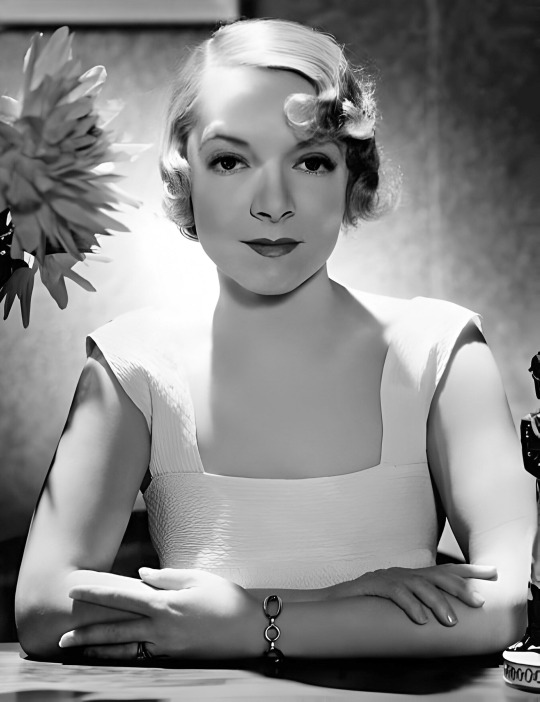



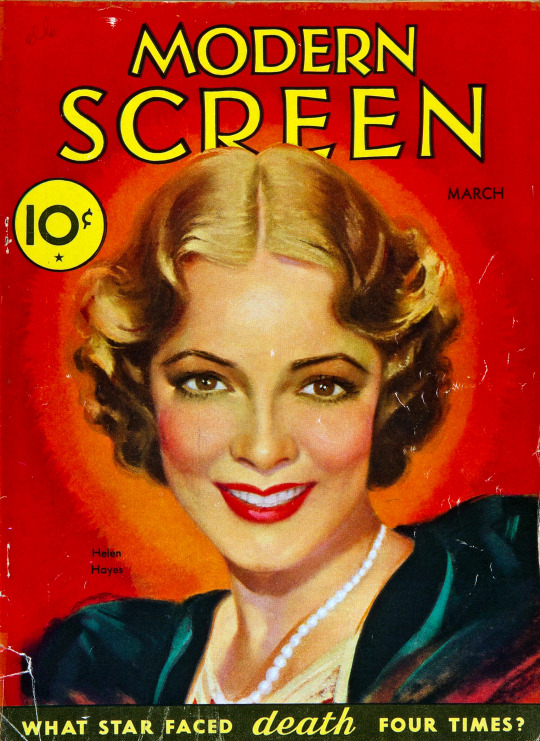
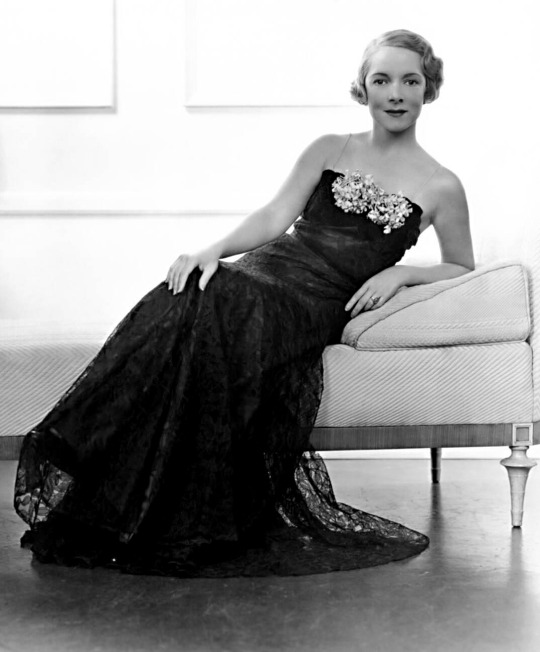

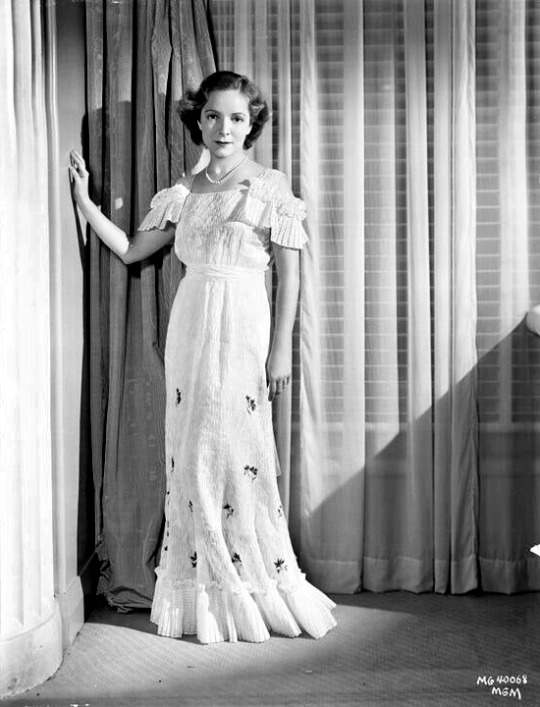




Helen Hayes MacArthur (born in Washington, D.C. on October 10, 1900 – March 17, 1993) was an American actress of Irish, Dutch, and English descent whose career spanned eighty-two years and regarded as the "First Lady of American Theatre."
Hayes made her stage debut at five with her mother's encouragement. At nine, she made her Broadway debut, and a year later, she was cast in the one-reel Vitagraph film.
She moved to Hollywood in 1931 when her husband became a screenwriter for Metro-Goldwyn-Mayer, where she also became a contract player. She made her film debut in The Sin of Madelon Claudet (1932), for which she received an Academy Award. Although she made a number of later films, within four years she returned to Broadway for the greatest success of her career: Gilbert Miller's production of Victoria Regina.
Hayes would return intermittently to Hollywood with featured roles in films, television, and radio, including a film comeback in disaster film Airport (1970), earning her a second Oscar. She retired in 1985 and spent her remaining years in her longtime home of Pretty Penny, in Nyack, New York, where she died of congestive heart failure at 92.
Legacy:
Was the first woman and second person to have won an Emmy, a Grammy, an Oscar, and a Tony Award (an EGOT)
Was also the first person to win the Triple Crown of Acting - the highest awards recognized in American film, television, and theater
Won two Academy Awards: Best Actress for The Sin of Madelon Claudet (1931) and Best Supporting Actress for Airport (1970)
Won one Primetime Emmy Award for Best Actress in 1953 and nominated for for nine more
Has three Tony Awards: two for Best Actress in a Play for Happy Birthday (1947) and Time Remembered (1958); and the Lawrence Langer Award for Distinguished Lifetime Achievement in the American Theatre
Won the Grammy Awards for Best Spoken Word Album for Great American Documents (1977)
Won the Distinguished Performance Award from the Drama League of New York Awards in 1936
Is one of the original inductees in the American Theatre Hall of Fame in 1972
Received the Golden Plate Award of the American Academy of Achievement in 1972
Inducted into the National Women's Hall of Fame in 1973
Selected as one of 10 artists to be commemorated with the American Arts Commemorative Series gold medallions issued by the Treasury Department in 1980
Is a founding member of the Board of Advisors of the Riverside Shakespeare Company of New York City in 1981
Co-founded the National Wildflower Research Center in 1982 with Lady Bird Johnson
Won the Award for Greatest Public Service Benefiting the Disadvantaged, given annually by Jefferson Awards, in 1983
Is the namesake for the annual Helen Hayes Awards, which has recognized excellence in professional theatre in Washington, D.C. since 1984
Received the Women's International Center (WIC) Living Legacy Award in 1985.
Recipient of the Ellis Island Medal of Honor by the Statue of Liberty-Ellis Island Foundation in 1986
Received the Presidential Medal of Freedom from President Ronald Reagan in 1986
Awarded the National Medal of Arts in 1988
Honored with a US postage stamp in 2011
Has a Broadway theatre named after her: the Helen Hayes Theatre on 44th Street
Served for 49 years on the Board of Visitors for the Helen Hayes Hospital, a physical rehabilitation hospital
Wrote three memoirs: A Gift of Joy, On Reflection: An Autobiography, and My Life in Three Acts
Has two stars on the Hollywood Walk of Fame: for motion pictures at 6258 Hollywood Boulevard and for radio at 6549 Hollywood Boulevard

#Helen Hayes#First Lady of American Theater#The Sin of Madelon Claudet#Airport#Victoria Regina#Silent Films#Silent Movies#Silent Era#Silent Film Stars#Golden Age of Hollywood#Classic Hollywood#Film Classics#Classic Films#Old Hollywood#Vintage Hollywood#Hollywood#Movie Star#Hollywood Walk of Fame#Walk of Fame#Movie Legends#Actress#hollywood actresses#hollywood icons#hollywood legend#movie stars#1900s#Broadway
3 notes
·
View notes
Note
Top 5 movies from the 20th century?
can i cheat and do two tops one with french movies and one without...thank you
french movies:
1. les parapluies de cherbourg (1964)
2. les demoiselles de rochefort (1967)
3. la nuit américaine (1973)
4. cléo de 5 à 7 (1962)
5. les diaboliques (1955)
non-french movies that are actually all american:
1. goodfellas (1990)
2. my own private idaho (1991)
3. they shoot horses, don't they? (1969)
4. before sunrise (1995)
5. clueless (1995)
this was a very fun ask thank you😁😁😁🫶🫶🫶
ask me my top 5 anything
#they stopped making french movies in 1974#movies that almost made the cut: the lady eve (1941) and after hours (1985). i'm a scorsesehead we know this#i also almost put stand by me but then i was like no that's just because you literally rewatched it 24 hours ago. but it was close#a fun detail in day for night which is what la nuit américaine is called for people who are...american and for others is that at one point#they're trying to pick a movie to see in theaters and they're like wow the godfather is playing everywhere i hear it's very good#and i'm sure it was a success right but it's not like they knew it was gonna be THAT big even fifty years later#so the first time i watched it i was like huh. that's fun#do you guys know about the truffaut godard feud this movie caused like they were bffs. until they weren't#this movie being la nuit américaine not the godfather#ask
3 notes
·
View notes
Text
She's Out To Please, She Pouts Her Best (Soldier Boy x Reader)

Summary: Soldier Boy’s been pulled from the European Theater to sell war bonds to the American people, the goodwill tour dotted by big cities and small towns alike. In the meantime, he gets familiar with the variety of women in dazzling costumes that accompany his speeches with carefully choreographed dances. You’re, without a doubt, his favorite of them all.
Note: Female (blink and you’ll miss it implied plus size) reader, but no other descriptors are used. This fic is so short because it’s pretty much PWP. Do not interact if you’re under 18 or post thinspo/ED content.
Word count: 2k
Warnings: Dressing room sex, mirrors, breeding kink, daddy kink, power imbalance, overstimulation, implied baby trapping. Do not interact if you’re under 18.

Chattering from the packed high school auditorium somehow seeped through the walls. The rural town that was the latest stop in Soldier Boy’s war bond drive had shown up en masse out of patriotism or sheer curiosity. Usually both. Electricity was always in the air before the show in small towns. Some of them didn’t even have movie theaters.
You and the other dancers on the tour had set up camp in one of the bigger classrooms, using it to get ready in since it was near one of the bathrooms. Dresses, sequins, and makeup scattered about the room, making the place of learning look like a department store had exploded inside. You’d been helping another girl with the curlers in her hair until a masculine voice called out your name from the doorway.
“Soldier Boy wants to see you in his dressing room.”
You nodded, giving an apologetic look to your colleague, who waved you off. It wasn’t unusual for Soldier Boy to call on one of you to help him “warm up” before the shows. Lately, however, he’d almost exclusively been asking for you, to the detriment of your jaw.
Grabbing a nearby tube of red lipstick, you hastily applied it in the illuminated mirror in front of you. The lipstick residue soon adorned a tissue that you discarded, and you used your fingertips to gently massage the muscles in your face in preparation for taking him again. You hoped you’d at least get to come this time.
A flyer had gotten you to this point, stark white with patriotic motifs, pinned to a board in the nightclub you had been working in prior to getting the gig. Uncle Sam declared, “Ladies, you can serve your country too!” You figured why not, there was a war on, and if you could do something to help, you might as well.
Your qualifications led you to your local USO office, where you were handed a star-spangled outfit and joined a gaggle of other girls to be the supporting act on Soldier Boy’s war bonds tour across the country. At times, you felt silly, kicking and shimmying to audiences who were clearly only putting up with the opener just to catch a glimpse at the world’s first superhero. A man larger than life in every sense of the word, as you and your fellow dancers on the tour would learn.
Wandering the hallway, you checked each door for an indication of which commandeered classroom was his. Not one for subtlety, his dressing rooms always had ‘SOLDIER BOY’ printed in large letters, declaring his presence. You found the sign toward the end of the hall, giving a smile to the usual group of people who congregated around him, assistants and handlers to keep him on schedule.
You knocked on the door, announcing your arrival.
“You wanted to see me, sir?” you asked when he opened the door.
He smiled, putting his hand on your lower back as he ushered you inside. “Sure did, sweetheart.”
His dressing room always betrayed his vices—alcohol, drugs, porno mags. It didn’t faze you anymore, not like the first time he asked for you, a stuttering mess in his presence. Back then, you had to take a shot with him to settle your nerves enough to blow him without feeling too self-conscious. Now, it was routine. You moved to get on your knees, but he stopped you, to your confusion.
Instead, he disarmed you with a passionate kiss that nearly knocked you over. You steadied yourself on his strong arms that had made their home near your hips. He squeezed them, pulling you closer so your body was flush against his as he slipped his tongue into your mouth.
You let him take the lead, he always did—strong, masculine, hard-working. Wasn’t America lucky its hero was easy on the eyes too? Except he had a temper, a mean streak that could go for miles. Not that you’d ever been on the receiving end of it. No, for all his faults, you seemed to get the best of Soldier Boy.
“I’ve been thinking about you,” he whispered against your lips.
“You have?”
“Don’t sound so surprised. You’re—“ he paused, searching for the word he wanted to use, “special to me.”
You weren’t sure why he was laying it on so thick. It wasn’t your first rodeo with him. “Special?”
“‘Course you are. You wouldn't be here if you weren’t,” he said. “I wanna try something different today, alright, doll?”
“Alright,” you agreed softly.
He smiled. “That’s my girl.”
Your body came alive at his praise, and you pressed your lips to his for another kiss. He guided your body backward until you bumped into the vanity. Parting his lips from yours, he turned you around, bending you over it so you were face to face with yourself in the mirror.
You looked at him from the reflection, brows furrowed as you wondered what he was doing.
He leaned down, voice husky in your ear as he growled, “I want you to see how pretty you look when you come.”
Your eyes widened, and you grabbed either side of the vanity in preparation, to his amusement. He pressed a kiss to the back of your neck as he pushed up your shimmery skirt, exposing your red, satin panties, specially made to be on display. Soon, your panties were around your heeled feet, one of his hands reaching to play with your clit while the other squeezed one of your breasts through your top.
“We look good together, don’t you think, sweetheart?” he asked, intense gaze studying your reactions.
“Y-Yes,” you moaned, trying to keep your eyes open.
He always wanted you to look at him. From your knees when you were sucking him off, when he’d be standing on the side of the stage during your act, in his hotel rooms when he couldn’t find local girls to fuck around with. This instance was different, though, able to really see him, and yourself. You didn’t find your glassy gaze or parted lips particularly flattering, but he couldn’t seem to get enough.
His fingers had already brought you close to climax, and you whined when he pulled them away from you for a moment to free his hard cock from his pants. You shuddered, feeling it on your skin before he guided it in your pussy. Your hands curled around the vanity you were bracing yourself on. You weren’t sure if you’d get used to how his cock seemed to split you apart every time.
One of his arms wrapped just below your chest to hold you up, as you struggled to support yourself when he started pounding into you. Your pussy was already wet and pliant for him, and you'd be embarrassed by the obscene squelching sounds if you weren't so focused on getting off when he had brought you so close to the edge already.
You were your own voyeur, your brain feeling like it was going to melt, watching yourself getting fucked by him. His superhuman strength always caught you off guard, from the first time he shocked you by lifting you above his head on stage for a roaring crowd to the way he could make your body feel—and look—like you were little more than a ragdoll.
“Gonna put a baby in you,” he grunted as he thrust into you, items falling from the vanity and onto the floor at the force he used to fuck you. “Want you up on that stage with my cum leaking out every time you kick up those legs—fuck—you’re mine.”
Your pussy clenched around him at the vulgar image he conjured up. “Yours daddy.”
His voice was strained, words slurring together. He was close. “‘S right, baby. Keep fuckin’ you ‘till you make me one. You like takin’ daddy’s dick, don’t you?”
You had to force the short affirmation out of your mouth, pleasure’s chokehold creeping up on you. That wasn’t enough for him or his ego.
“I wanna hear you say it.”
“I love taking—oh fuck—taking your dick, daddy.”
He came, hard and sloppy as your pussy milked his cock. You cried out, feeling so full it almost started to hurt. Something in you finally snapped, releasing the pain and pressure as you rode out your orgasm on his softening cock. Your arms gave out from under you so that it was just his strength holding you up. You weren’t sure how you’d be able to go back to having sex with men who weren’t well-endowed superheroes. Go back to faking it, you supposed.
Your throat was sore. You hadn’t paid attention to how loud you were being. Everyone outside the room must’ve known what was happening if they didn’t have an idea when you first showed up looking for him.
Soldier Boy pulled himself out of you, and you could hear fabric rustling and the sound of his zipper again. You didn’t bother trying to stand up, still needing time to catch your breath.
He used his fingers to swipe up some of his cum that had begun dripping out of you, causing you to gasp at the slight sensation of them brushing against your pussy. You whimpered when he pushed his index and middle fingers inside you, already aching from the orgasm he’d just pulled from you.
“I—I can’t—“
‘I can’t get pregnant and ruin my career,’ you wanted to say, but all that came from your lips was a desperate, animalistic moan.
“I got you, baby,” Soldier Boy whispered, voice low and husky in your ear. “Give me one more so it sticks.”
You choked on air as his thumb brushed your clit, rubbing circles in the sensitive bundle of nerves. His fingers pushed deeper, and your hips bucked at the overstimulation, your spent pussy reactively pulsing around his cum-slicked fingers that curled inside you.
The woman staring back at you in the mirror was a mess with her mascara stained cheeks and smeared lipstick. You were utterly unrecognizable as you came again, harder on his fingers this time, crying out as you gripped the edge of the vanity, threatening to break one of your manicured nails.
“Good girl,” he praised, pressing kisses to your cheek, as you came down from your second orgasm, pulling his hand from between your legs. “You alright?”
“I think so,” you breathed. “Jesus Christ.”
Your legs felt like jelly beneath you, and you wondered how the hell you were going to be able to dance in less than half an hour. You’d have to reapply all of your makeup too.
He turned you around, looking at you with a brief fondness before kissing your lips, soft and quick.
“I need to fix my face,” you breathed.
He smiled. “Why? You look great.”
You laughed softly as he gave you space. You pulled up your panties from around your ankles, knowing his cum would stain them by the time you made it back to the dancers’ makeshift dressing room. Taking some of the tissues from the box on top of the vanity, you began wiping your ruined makeup from your face. He stared at you in silence from the spot he’d taken on the loveseat that’d been brought in for him.
“I think I’d be a good father. Better than my old man,” he said finally.
You paused, looking at him from the mirror, giving him a sardonic smile. “I don’t see you as the settling down type.”
“Maybe I just need a woman worth coming home to.”
“Maybe,” you echoed.
“C’mere.”
You obliged, joining him on the loveseat. He wrapped an arm around you, holding you close. You let yourself bask in the intimacy.
“Things aren’t always gonna be like this,” he said. “Once the war’s over, what’re you gonna do? Go back to dancing in nightclubs?”
“Why not?”
His jaw clenched, cheek twitching as he pulled his gaze from you. “I don’t want you doing this for anyone but me.”
This could have been any number of things, dancing, fucking, being at his beck and call. Knowing him, he meant all of it.
“Ben,” you said, grabbing his attention, “then you have to tell me what you do want.”
“I want you. I want the white picket fence, kids running around the yard with the dog,” he said, the intensity in his voice wrapping tendrils around your mind, pulling you into the world he was describing. “I want dinner to burn ‘cause I was busy putting another baby in you when I got home.”
“Oh,” you whispered.
A voice through the door startled you. “Soldier Boy, the mayor’s here to see you!”
“Think about it,” Soldier Boy said, getting up from the loveseat to grab his helmet and shield.
The door shut behind him, leaving you to agonize over the future he presented to you. Part of you wondered if you’d really have a choice.
#soldier boy x reader#the boys x reader#soldier boy#soldier boy the boys#soldier boy imagine#soldier boy smut#the boys#the boys amazon#the boys tv
2K notes
·
View notes
Text

everyone look at the lady in the portrait gallery who looks just like me
0 notes
Text


Propaganda
Josephine Baker (The Siren of the Tropics, ZouZou)— Josephine Baker was an American born actress, singer, and utter icon of the period, creating the 1920s banana skirt look. She was the first black woman to star in a major motion film. She fought in the French resistance in WWII, given a Legion of Honour, as well as refusing to perform in segregated theatres in the US. She was bisexual, a fighter, and overall an absolutely incredible woman as well as being extremely attractive.
Joan Crawford (Dancing Lady, Mildred Pierce, The Women)— God, where do I start!!! Her face is so UNIQUE and compelling and stands out so much. I love her thick brows and high cheekbones. She has a school-marmy hardness too her that makes her a little scary and therefore sexy. Her low thick voice also does it for me. Despite being an unusual looking woman with an unusual face, she never loses her glamour. Just a gorgeous talented actress, AND she was some sort of gay!!!
This is round 5 of the tournament. All other polls in this bracket can be found here. Please reblog with further support of your beloved hot sexy vintage woman.
[additional propaganda submitted under the cut. the famous banana skirt is mildly NSFW.]
Josephine Baker:
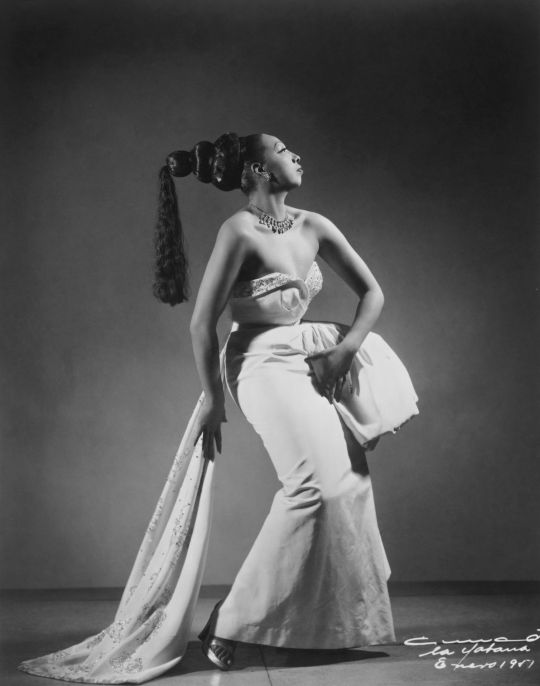
Black, American-born, French dancer and singer. Phenomenal sensation, took music-halls by storm. Famous in the silent film era.
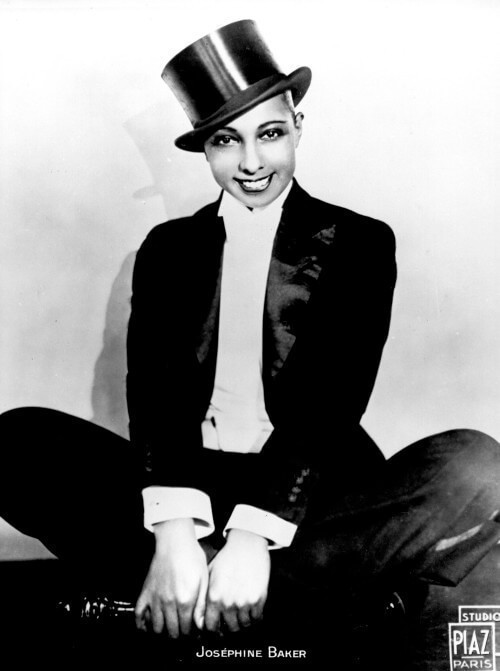
Let's talk La Revue Negre, Shuffle Along. The iconique banana outfit? But also getting a Croix de Guerre and full military honors at burial in Paris due to working with the Resistance.

She exuded sex, was a beautiful dancer, vivacious, and her silliness and humor added to her attractiveness. She looked just as good in drag too.



So I know she was more famous for other stuff than movies and her movies weren’t Hollywood but my first exposure to her was in her films so I’ve always thought of her as a film actress first and foremost. Also she was the first black woman to star in a major motion picture so I think that warrants an entry
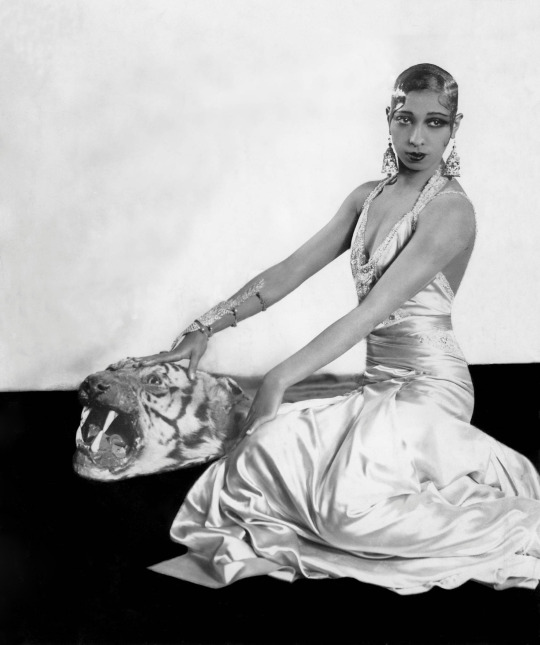
Iconic! Just look up anything about her life. She was a fascinating woman.
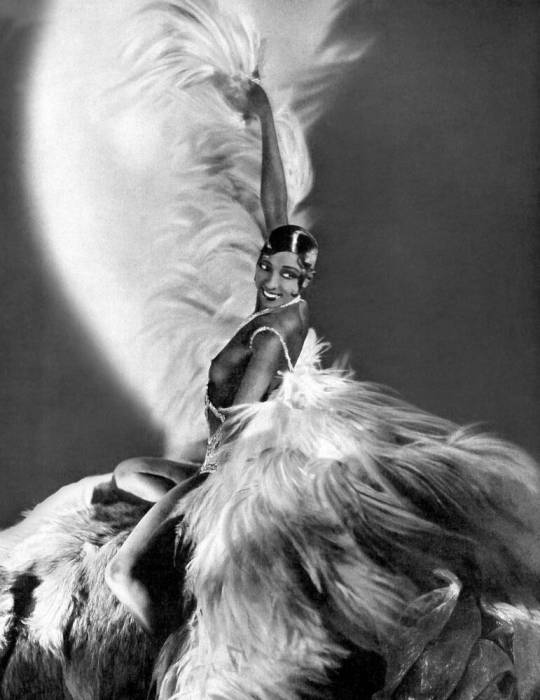
Joan Crawford:

I just love women that are very mean.

she was a smoke show in every decade, from the 20s to the 60s.
The classic matronly beauty with amazing eyebrows


of course there's a space for MILF joan but i want to just take a second and say she was so cute in her early movies (like grand hotel and the women)! those parts often get forgotten but her stardom shines in them just as much as in her older #queen #icon roles

Misremembered for wire hanger hatred, this original screen queen mastered the art of the comeback and refused to let Hollywood toss her aside as she aged. The term “auteur” is usually revered for directors or writer-directors, but most critics have one actor they’ll give that title to as well: Crawford—anyone who knows classic movies already has a “Crawford picture” in their head. She knew how to style herself and promote herself. She made herself a star and kept herself fixated in the Hollywood firmament. What’s hotter than knowing just how hot you are?
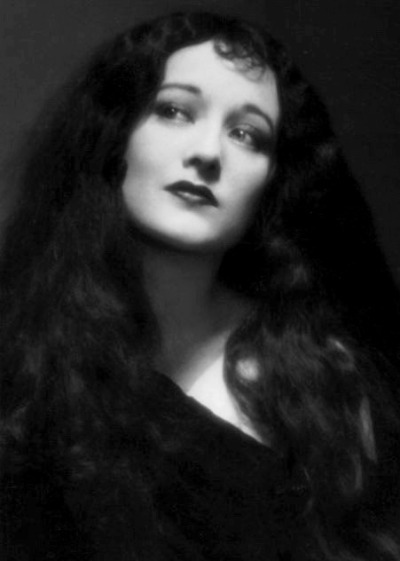

(don’t think about Mommie Dearest right now) Joan was known for being super nice to all the like crew of the movies she worked on and she’d get everyone gifts. Joan would hold movie nights at her house and knit at the back of her home theater. Joan was sooo obsessed with other women including Greta Garbo, whos dressing room she would obsessively and purposefully walk by. She said that while working on Grand Hotel, Garbo grabbed her face and “if there ever was a time in my life where I would’ve been a lesbian, that was it.” But like Joan also probably did sleep with women including Barbara Stanwyck. Joan was so obsessed with Bette Davis, screening multiple movies of hers in a day at her watch party, constantly trying to spend time with her or do a movie together, insisting on the dressing room next to hers at Warners and sending her daily gifts… etc. Once Bette said that sex was gods joke to humanity and Joan said “I think the joke is on her.” Joan fucked a lot. Joan got caught publicly fucking a man and sent a letter to the woman who saw them basically saying “I bet it excited you” and the woman was like you know what. It did. Joan was best friends with a gay man. Joan was an actually genuinely good actress even though people mocked her a lot for being like cheap and stupid (partially because she never finished school because her family was broke). Joan was so insane and so cool that’s all.

213 notes
·
View notes
Text
Evelyn Preer

Evelyn Preer (née Jarvis; July 26, 1896 – November 17, 1932), was an African American pioneering screen and stage actress, and jazz and blues singer in Hollywood during the late-1910s through the early 1930s. Preer was known within the Black community as "The First Lady of the Screen."
She was the first Black actress to earn celebrity and popularity. She appeared in ground-breaking films and stage productions, such as the first play by a black playwright to be produced on Broadway, and the first New York–style production with a black cast in California in 1928, in a revival of a play adapted from Somerset Maugham's Rain.
Evelyn Jarvis was born in Vicksburg, Mississippi, on July 26, 1896. After her father, Frank, died prematurely, she moved with her mother, Blanche, and her three other siblings to Chicago, Illinois. She completed grammar school and high school in Chicago. Her early experiences in vaudeville and "street preaching" with her mother are what jump-started her acting career. Preer married Frank Preer on January 16, 1915, in Chicago.
At the age of 23, Preer's first film role was in Oscar Micheaux's 1919 debut film The Homesteader, in which she played Orlean. Preer was promoted by Micheaux as his leading actress with a steady tour of personal appearances and a publicity campaign, she was one of the first African American women to become a star to the black community. She also acted in Micheaux's Within Our Gates (1920), in which she plays Sylvia Landry, a teacher who needs to raise money to save her school. Still from the 1919 Oscar Micheaux film Within Our Gates.
In 1920, Preer joined The Lafayette Players a theatrical stock company in Chicago that was founded in 1915 by Anita Bush, a pioneering stage and film actress known as “The Little Mother of Black Drama". Bush and her troupe toured the US to bring legitimate theatre to black audiences at a time when theaters were racially segregated by law in the South, and often by custom in the North and the interest of vaudeville was fading. The Lafayette Players brought drama to black audiences, which caused it to flourish until its end during the Great Depression.
She continued her career by starring in 19 films. Micheaux developed many of his subsequent films to showcase Preer's versatility. These included The Brute (1920), The Gunsaulus Mystery (1921), Deceit (1923), Birthright (1924), The Devil’s Disciple (1926), The Conjure Woman (1926) and The Spider's Web (1926). Preer had her talkie debut in the race musical Georgia Rose (1930). In 1931, she performed with Sylvia Sidney in the film Ladies of the Big House. Her final film performance was as Lola, a prostitute, in Josef von Sternberg's 1932 film Blonde Venus, with Cary Grant and Marlene Dietrich. Preer was lauded by both the black and white press for her ability to continually succeed in ever more challenging roles, "...her roles ran the gamut from villain to heroine an attribute that many black actresses who worked in Hollywood cinema history did not have the privilege or luxury to enjoy." Only her film by Micheaux and three shorts survive. She was known for refusing to play roles that she believed demeaned African Americans.
By the mid-1920s, Preer began garnering attention from the white press, and she began to appear in crossover films and stage parts. In 1923, she acted in the Ethiopian Art Theatre's production of The Chip Woman's Fortune by Willis Richardson. This was the first dramatic play by an African-American playwright to be produced on Broadway, and it lasted two weeks. She met her second husband, Edward Thompson, when they were both acting with the Lafayette Players in Chicago. They married February 4, 1924, in Williamson County, Tennessee. In 1926, Preer appeared on Broadway in David Belasco’s production of Lulu Belle. Preer supported and understudied Lenore Ulric in the leading role of Edward Sheldon's drama of a Harlem prostitute. She garnered acclaim in Sadie Thompson in a West Coast revival of Somerset Maugham’s play about a fallen woman.
She rejoined the Lafayette Players for that production in their first show in Los Angeles at the Lincoln Center. Under the leadership of Robert Levy, Preer and her colleagues performed in the first New York–style play featuring black players to be produced in California. That year, she also appeared in Rain, a play adapted from Maugham's short story by the same name.
Preer also sang in cabaret and musical theater where she was occasionally backed by such diverse musicians as Duke Ellington and Red Nichols early in their careers. Preer was regarded by many as the greatest actress of her time.
Developing post-childbirth complications, Preer died of pneumonia on November 17, 1932, in Los Angeles at the age of 36. Her husband continued as a popular leading man and "heavy" in numerous race films throughout the 1930s and 1940s, and died in 1960.
Their daughter Edeve Thompson converted to Catholicism as a teenager. She later entered the Sisters of St. Francis of Oldenburg, Indiana, where she became known as Sister Francesca Thompson, O.S.F., and became an academic, teaching at both Marian University in Indiana and Fordham University in New York City.
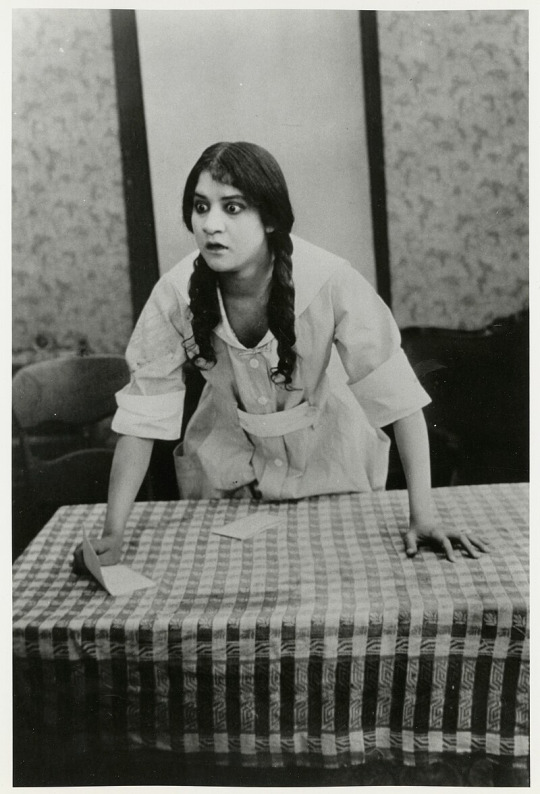
Still from the 1919 Oscar Micheaux film Within Our Gates.
60 notes
·
View notes
Text
HSR THEORIES - PENACONY ANALYSIS
I guess I'm late to the game, but I'm normally a lore gremlin for Xianzhou lore, not Penacony lore. Anyways, don't expect something very elaborate, but you'll be able to find :
Reflection on the period based on history (Penal Colony)
Reflection on the period based on fashion (NPC in trailers)
Reflection on the period based on architecture (Art Deco)
Reflection on the period based on cultural shift (Railway Mania, Department Stores)
Reflection on lore based on Literature (Jules Vernes, Herman Melville)
Reflection on lore based on Philosophy (Idealism, Utilitarianism, Transcendental Idealism)
Everything under the cut as always since I tend to babble.
The name "Penacony" possibly comes from the phrase "penal colony".
I'm certainly not the first to make the connection, but "Penal Colony" inevitably brings to mind Australia. This idea of "Space Australia" is also reinforced by the names for the characters we know at the moment, with a very clear English etymology : Sunday, Robin, Gallagher, Firefly.
The use of Australia as a "penal colony" by England took place after the American War of Independence, so we start with a period around 1780 to ~1870.
youtube
We didn't get to see a lot of NPC outfits in this very short clip, but what little there is could actually correspond to a period like this. However, we had a little more hints in Honkai Star Rail - Penacony Trailer | Game Awards 2023, where we see Acheron at the reception of the Reverie hotel :

This NPC in particular is interesting, because of her gloves. It's called "evening gloves" or "opera gloves". They were popular during the Napoleonic period (1800-1825) but were also very fashionable in the last two decades of the 19th century, i.e. 1880-1900 and before WWI, i.e up to 1910.
In terms of temporality, it is also important to note what concerns the architecture of Penacony.
It was noted on Reddit that the style of architecture could be reminiscent of the French Art Deco style, an architectural movement predominant in the 1910s to 1920s. Art Deco is said to have represented "luxury, glamour, exuberance, and faith in social and technological progress", so quite fitting for Penacony. Key features were : geometric/sleek designs, bold colors, luxurious materials, things that we find in the previews.
We'll have to wait to see more from Penacony, but it might be interesting to see if there is also any inspiration from the previous movement, Art Nouveau 🤔
Another architectural thing :
Look up and see the metal tracks crisscrossing the skyscrapers and the Spheroids rapidly rolling along them. They are the most visible means of transportation in this dreamscape metropolis and guide guests to each and every place around the city. [x]
This part about the Spheroids is interesting, because during this period (starting from 1825, with a peak in the 1840s), there was in France and England what we called the Railway Mania.
This is a point of interest because the Railway Mania saw the the arrival of the railroads in Paris. When it happened, this caused another major cultural shift : the rise of Department Stores. There is even a well-known french novel on the subject, called Au Bonheur des Dames (The Ladies' Delight) by Emile Zola.

The end of the 19th century is also the period of birth of modern advertising and given the number of things that we see plastered all over Penacony, I think I can say that we are on the right track/period.
So, in terms of rough "era", we can go from 1780 to ~1920, so mostly the 19th century (1800-1900).
Speaking of period culture and Penacony in general, we currently have a Relic Set which I will use for the rest of the post: Penacony's Dream-Seeking Tracks
Opening a window no longer show a view of the stars in the deep sky, but of the city's shifting streams of light and shadows, holding up the constant echoes of giant clocks and theaters.
Okay, let's start with some details that I only noticed because I come from a literary studies background. I'm not going to lie to you, it's far-fetched, but stay with me, I promise it's interesting.
Giant clocks and theaters made me think "steampunk" works, whose setting are often set in an alternative history of the Victorian era (~1837 to 1900, so right in our period). One of the pioneering writers of the genre, “proto-steampunk” so to speak, is Jules Vernes, considered one of the "father of science fiction".
Remember Spheroids ? : "Spheroids are regarded as both vehicles and as toys in the land of dreams. However, few remember that the Spheroids are actually imprisonment cages — the vehicle towards dreams are tools originally used for locking up prisoners."
One of Jules Vernes' best-known novels is Twenty Thousand Leagues Under the Seas, a science-fiction aventure novel the majority of which takes place aboard the Nautilus, a submarine belonging to Captain Nemo. And interesting thing, "he also tells his new passengers that his secret existence means he cannot let them leave — they must remain on board permanently" ; They are prisoners in the Nautilus.
On another point, Jules Vernes is also considered as having had a strong influence on the surrealist movement "in which artists depicted unnerving, illogical scenes and developed techniques to allow the unconscious mind to express itself. Its aim was, according to leader André Breton, to "resolve the previously contradictory conditions of dream and reality into an absolute reality, a super-reality", or surreality"." Quite fitting for our dream planet.
For the next one... Well. I have no excuse for this one, it's even more far-fetched. But so, we remain in the literary universe.
The water from the spring turn into a giant whale and swim through the halls.
Giant whale made me think of one thing almost immediately : Moby Dick, by Herman Mellville, published in 1851 (once again in our era of interest). Moby Dick is a "sea novel" centered around the figure of the hunt of a whale. It's main themes are the limits of knowledge, fate and free will, nature and man, race, fellowship, and enslavement, madness and religion [x].
I wont copy and paste the whole shtick but I send you check again The Family description from the Data Bank.
With that, we're done with literature... so it's time to move on to something else wonderful and terrible, the greatest enemy of my high school years (when you have to do it for 8 hours a week, it quickly becomes tiring), I named: PHILOSOPHY.
For a transcendent experience, for an inspirational excitement, for the soothing of worries and wounds — guests of the highest caliber come to surrender their pain in exchange for peace and tranquility
I'm not going to dwell on that for too long, quite honestly. I'll just... put that here for you to do whatever the fuck you want with it.
Idealism : "Idealism in philosophy, also known as philosophical idealism or metaphysical idealism, is the set of metaphysical perspectives asserting that, most fundamentally, reality is equivalent to mind, spirit, or consciousness; that reality is entirely a mental construct; or that ideas are the highest form of reality or have the greatest claim to being considered "real"
At some unknown point in time, the small cells cut off access to reality, but people's consciousnesses became linked in dreams. In the midnight bell, that shared dream seemed so real, reflecting the sheer hypocrisy of reality.
Utilitarianism : "a family of normative ethical theories that prescribe actions that maximize happiness and well-being for the affected individuals. In other words, utilitarian ideas encourage actions that ensure the greatest good for the greatest number."
Those who follow the "Harmony" Path admire understanding, support, and cooperative behavior.
In addition to all previously "said", one of the greatest thinkers of the time, who is also the one at the origin of the definition of transcendent, is Immanuel Kant. His best known work is Critique of Pure Reason (1781), with which "he aims to reach a decision about "the possibility or impossibility of metaphysics".
Metaphysics "is the branch of philosophy that studies the fundamental nature of reality. This includes the first principles of: being or existence, identity, change, space and time, cause and effect, necessity, actuality, and possibility."
This work was the founding work of a philosophical doctrine known under the name of Transcendental Idealism. I'll spare you the convoluted explanations but look at that :
The scenery gradually becomes more and more incredulous, and the senses feel as if one has been lifted by silk. [...] The guests finally realize that they were never awake, but are instead witnessing Penacony's true nature in a dream — a place where time stops in a neverending dreamscape.
"Kant means that his philosophical approach to knowledge transcends mere consideration of sensory evidence and requires an understanding of the mind's innate modes of processing that sensory evidence".
"Kant outlines how space and time are pure forms of human intuition contributed by our own faculty of sensibility. Space and time do not have an existence "outside" of us, but are the "subjective" forms of our sensibility".
68 notes
·
View notes
Text
i can't stay quiet about this anymore. for weeks now i've thought, noo i won't write about knights of the zodiac on my blog. nobody cares. BUT it is the weirdest fucking movie i've ever seen and i need to tell you about it.
knights of the zodiac is an american made live action adaptation of the anime/manga saint seiya. before this film, i'd never even heard of it, but that doesn't matter, because i watched an interview with mackenyu (who plays seiya) who said that the director told him not to bother watching the anime or reading the manga, because he wanted this movie to be its own thing. you know, which is always a great way to bring in your core audience.
with that said, i'm viewing this film entirely on its own merit, with no context of the source material. so saint seiya fans may not want to read this.
the movie came out this past may. i was excited about it for no other reason than mackenyu starring in an american action movie. i'm honestly a little surprised people weren't more jazzed about that. there aren't a lot of japanese actors starring in big budget american action movies.
other cast members include sean bean (who, spoiler alert, dies), famke janssen, and mark dacascos. in case you don't recognize those names, they are, respectively, boromir/ned stark, jean grey from x-men, and the iron chef. if nothing else, i think it's worth watching for the utterly bizarre casting.
the premise, sort of: mackenyu, who appears to be contractually obligated to play angsty younger brother characters (i think this is the 7th thing i've seen him in where he is an angsty younger brother), has an older sister who is missing. he's a poor orphan boy who gets by on winning cage fights. or something. so boromir finds him and tells him he's destined to be athena's bodyguard, and he gets on board with this alarmingly fast, but not after antagonizing athena (who is not yet athena) and throwing out some snarky one-liners. he trains in the middle of nowhere with a masked lady who repeatedly kicks his ass, and he never changes clothes the entire time. there's other stuff too but it's secondary to the absolute batshittery of this movie.
i saw it on premiere night, which was also the premiere night of the new guardians of the galaxy movie. again, A+ move by the promotional team. so there i was on a saturday at 7pm. prime movie going time. and my best friend and i were the only ones in the theater.
although i had no real expectations for this movie beyond Mackenyu Hits Things And Is Sad, i believed one of two things would happen: it would be as terrible as it sounded, or it would actually be phenomenal. but no, it was neither bad, nor good, but a secret third thing: it scratched a deep and rabid part of my id.
and by that i mean, it appeared to be a very high budget love letter to glaringly submissive men.
here's my letterboxd review that i wrote in the brief hypomanic episode succeeding my initial viewing:

okay so first and most importantly, this scene made me actually scream:
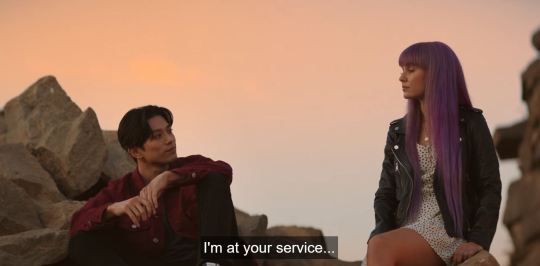
it's a joke line, sure, but 1) he definitely means it, and 2) he immediately calls her "princess," which if you've ever read my fic, you'll know that that's a one-hit KO for me.
(putting this under a cut because it's already long)
you see how athena is framed above seiya? that is one of approximately 1000 shots where this occurs. to every male character. at one point, mackenyu perches gingerly on the back of athena's motorcycle. in fact the only male character who attempts to be dominant aggressive and toxically masculine becomes the punching bag of the film.
in the beginning, seiya is in a cage match where people are getting angry at him for "dancing," which means he doesn't fight so much as avoids getting hit and looks pretty doing it. a solid third of the movie involves a very large lady beating the crap out of him. the premise of the film is getting him to devote his entire life to a goddess and obey protect her at all costs.
i'm probably the only one who watched this movie and was like, hmm is this kink coded? am i insane for seeing this? usually when i think of kink coding i think of quentin tarantino's foot fetish, these long gaudy shots of women's feet hanging out of car windows. it's in the imagery and shot composition and power dynamics.
here, the imagery is a lot of kneeling men, the shot compositions repeatedly place the men lower than the women, and the power dynamics are simply that the women have all the power, and the men have a little, as a treat. jean grey is a straight-up femdom, leather and all.
by the end of the climax, seiya is naked, having been stripped of his (magical and very powerful) armor as pre-athena becomes athena and uh, blasts his clothes off in the process. there's probably something to be said there about, you know, literally stripping him of his power.
i think what i find particularly remarkable about this is that the repeated feminization of the male lead is treated as a good thing. a self-actualizing thing. it's the process through which he accepts himself and his destiny. that's the reason i say it's a love letter--i've known a lot of submissive men and many of them really struggle to accept that part of themselves. i had a friend once who was so ashamed of himself--not just that he was submissive, but that submission was an integral part of his identity--that he had a breakdown in my car over it. so i think it's nice seeing a vaguely positive portrayal of finding oneself through (textually) devotion and (subtextually) submission.
god help me, seiya spends the entire film being irritating and bratty. this movie is my personal kryptonite.
don't get me wrong, it's a terrible movie. the writing is awful, the direction is awful, and if it gets a second film, i'll be shocked. it received a 1.9 (out of 5) on letterboxd and a 4.4 (out of 10) on imdb.
but i've also always been a lover of the star wars prequels (and oh boy there's a lot to be said there about submissive men) and so my patience for bad writing is infinite in the face of interesting things happening on a character level. in a world of disneyfied stock plots and bloated marvel franchises, i appreciate when a movie tries to do something different, even if it doesn't do it very well.
anyway, i can't in good conscience recommend it, but i for one plan to watch it at least a hundred more times.
#i would love to tag this so i can find it later but i really don't want it to show up in the official tag#so uhh#film meta
177 notes
·
View notes
Text


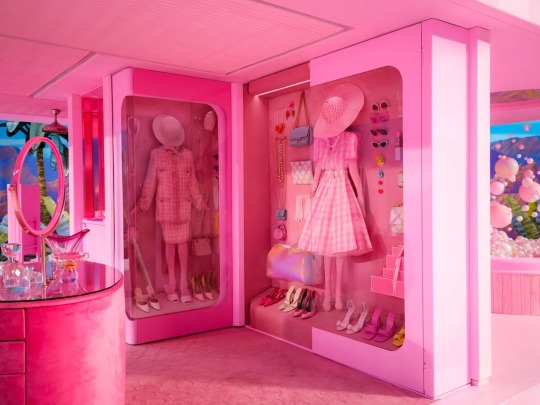
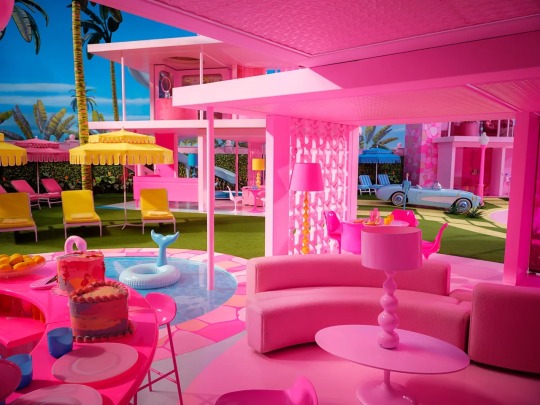


Inside the Barbie Dreamhouse, a Fuchsia Fantasy Inspired by Palm Springs
Barbie’s Dreamhouse is no place for the bashful. “There are no walls and no doors,” says Greta Gerwig via email. “Dreamhouses assume that you never have anything you wish was private—there is no place to hide.” That layered domestic metaphor has proved rich fodder for the filmmaker, whose live-action homage to the iconic Mattel doll hits theaters July 21.
To translate this panopticon play world to the screen, Gerwig enlisted production designer Sarah Greenwood and set decorator Katie Spencer, the London-based team behind such period realms as Pride & Prejudice and Anna Karenina. The two took inspiration from Palm Springs midcentury modernism, including Richard Neutra’s 1946 Kaufmann House and other icons photographed by Slim Aarons. “Everything about that era was spot-on,” says Greenwood, who strove “to make Barbie real through this unreal world.”
Neither she nor Spencer had ever owned a Barbie before, so they ordered a Dreamhouse off Amazon to study. “The scale was quite strange,” recalls Spencer, explaining how they adjusted its rooms’ quirky proportions to 23 percent smaller than human size for the set. Says Gerwig: “The ceiling is actually quite close to one’s head, and it only takes a few paces to cross the room. It has the odd effect of making the actors seem big in the space but small overall.”
Erected at the Warner Bros. Studios lot outside London, Barbie’s cinematic home reinterprets Neutra’s work as a three-story fuchsia fantasy, with a slide that coils into a kidney-shaped pool. “I wanted to capture what was so ridiculously fun about the Dreamhouses,” says Gerwig, alluding to past incarnations like the bohemian 1970s model (outfitted with trompe l’oeil Tiffany lamps) and the 2000 Queen Anne Victorian manse, complete with Philippe Starck lounge chairs. “Why walk down stairs when you can slide into your pool? Why trudge up stairs when you take an elevator that matches your dress?” Her own references ranged from Pee-wee’s Big Adventure to Wayne Thiebaud’s paintings of pies to Gene Kelly’s tiny painter’s garret in An American in Paris.
For Barbie’s bedroom, the team paired a clamshell headboard upholstered in velvet with a sequined coverlet. Her closet, meanwhile, reveals coordinated outfits in toy-box vitrines. “It’s very definitely a house for a single woman,” says Greenwood, noting that when the first Dreamhouse (a cardboard foldout) was sold in 1962 it was rare for a woman to own her own home. Adds Spencer: “She is the ultimate feminist icon.”
In Barbie, as in previous films like Little Women and Lady Bird, Gerwig set out to realize a whole world. “We were literally creating the alternate universe of Barbie Land,” says the director, who aimed for “authentic artificiality” at every opportunity. As a case in point, she cites the use of a hand-painted backdrop rather than CGI to capture the sky and the San Jacinto Mountains. “Everything needed to be tactile, because toys are, above all, things you touch.”
Everything also needed to be pink. “Maintaining the ‘kid-ness’ was paramount,” Gerwig says. “I wanted the pinks to be very bright, and everything to be almost too much.” In other words, she continues, she didn’t want to “forget what made me love Barbie when I was a little girl.” Construction, Greenwood notes, caused an international run on the fluorescent shade of Rosco paint. “The world,” she laughs, “ran out of pink.”
#obsessed is an understatement#barbie#movie sets#set design#barbie 2023#greta gerwig#architecture#interior design#interiors
218 notes
·
View notes
Text
Okay I watched episode 1 and 2 of Masters of the Air and I loved them! And since I have a special interest in women in WWII, I'd like to look deeper at the show to see how historically accurate it is for people who may be into the show but might not know much of the history
So let's talk about the women!!
Put under a read more because I got way to into it and it got long
First up let's look at the civilian women we see. There's a lot of background women and they all look fantastic. Their dresses, the cardigans, the patterns on the blouses, skirts, and dresses, the hairstyles, the jewelry are all so good. I love that you see a variety of updos and longer hairstyles yet they've all got the curls correct. I see rolls and pin curls and even milkmaid braids. Fantastic!

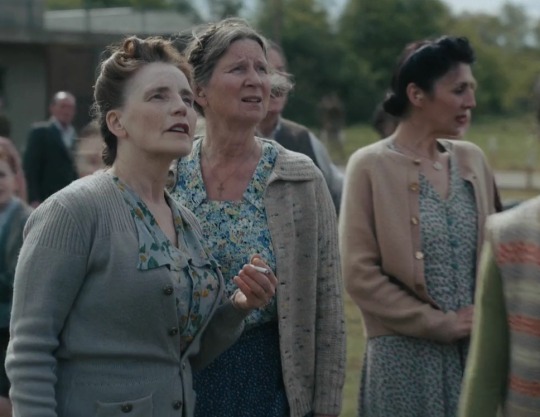
But for some reason, Marge and her friend? Not so much. Marge is obviously a major character being the love interest of Gale Cleven. Their dresses are both fine. It's their hair that bothers me. It's like they tried a wet set curl but forgot to use setting lotion so the curls fell halfway through filming.


This is bad. Especially Marge's hair. This is a modern slightly wavy hairstyle and nothing like a 1940s hairstyle should be. They should have gone more like this. 1940s, especially early 1940s, was all about the curls. Wet sets and victory rolls. Updos were the go to for evening but if you wanted to wear your hair long it'd be more like this:

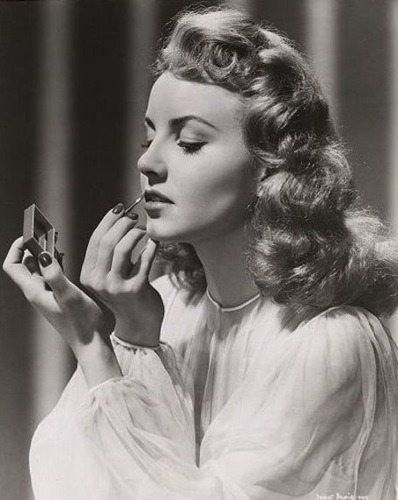
Why can't tv dress main characters as well as the background women? I don't get it.
Next up is the Women's Land Army. We only see them in the background but there's enough there for me to say that they look absolutely fantastic. I'm so happy.
First off, let's talk about what they're wearing.



We see the corduroy trousers, khaki dungarees, green headscarf, and black wellies that are a part of the WLA uniform. Several of them are wearing the tan shirt sleeve uniform shirt as well and I see at least two wearing the green jumper. The rest are wearing civilian sweaters and blouses which was allowed. The hair styles are perfect too. Love seeing the scarves, gibson rolls, and turbans.
For an even closer look we can take a look at the behind the scenes photos shared by Danni Philips. You can see the Women's Land Army pin on their uniform which pleases me so much you have no idea. And you can further see that the forest green sweater they're wearing is utter perfection.
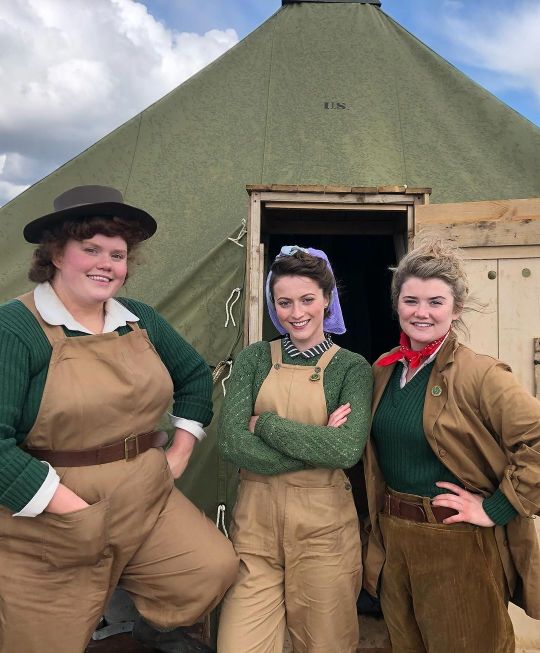
Some original WLA photos:


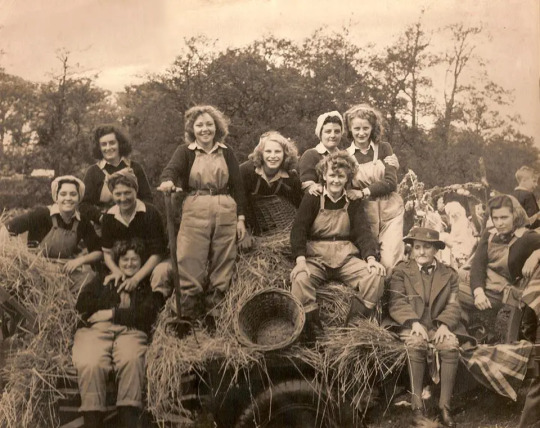
Now what about the work they're doing? We can see the women driving cattle and harvesting what I believe is wheat but crops are not my specialty so I might be wrong there but both of which are two jobs done by much of the Land Army. Here's some side by side examples of the show vs original photos:
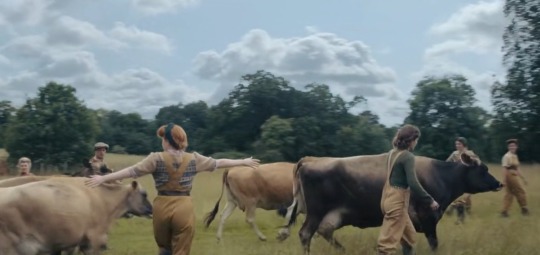
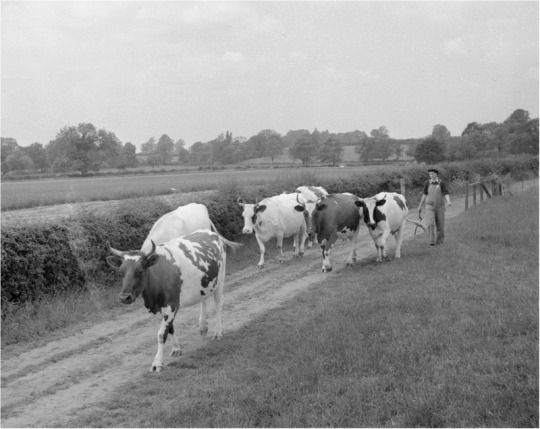
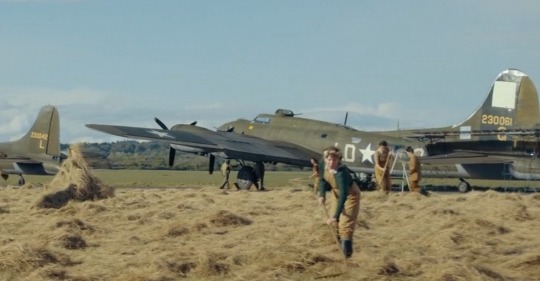
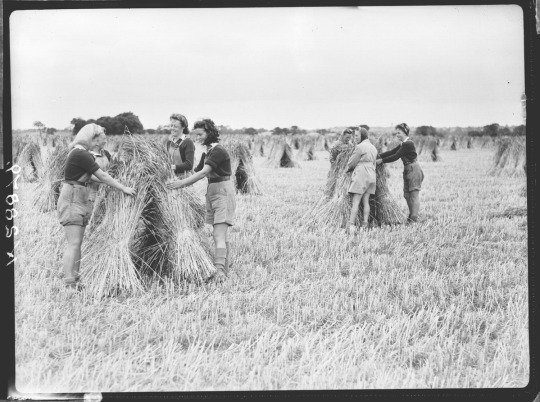
So good!!
Okay now let's talk about the Red Cross women we see. The first time we see them is this scene after the bomber crews get back from a flying mission. These ladies are a part of a Red Cross Clubmobile which you can get a quick glimpse of the Clubmobile here:
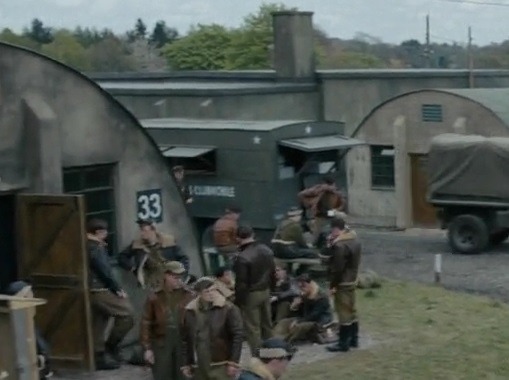
We see them handing out donuts and coffee to the men as they come in for interrogation which ABSOLUTELY was something the Red Cross did!! They established aeroclubs and had Clubmobiles stationed on air bases to provide relaxation and coffee and donuts for the base. Here's an example of them giving coffee and donuts to returning airmen on their way to interrogation which so closely resembles the show I nearly lost it.


One of my favorite details is the jacket that one Red Cross woman on the left wears. She's got a whole bunch of patches sewn on the sleeve of her jacket which is something a lot of women did when they served overseas. I've seen a bathrobe with dozens of patches sewn on and a large piece of fabric one WAC hung in her tent.
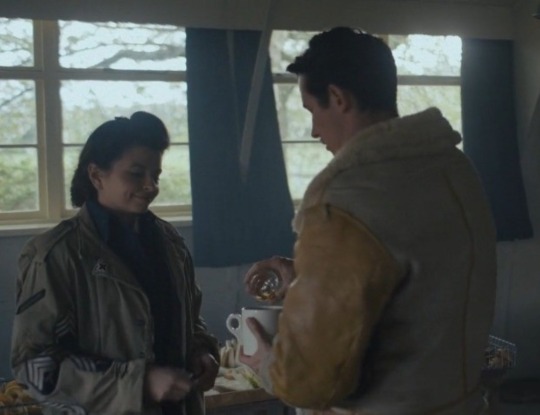
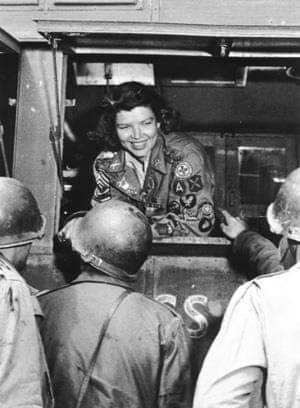
Now how about the uniforms they wear? The ladies above are wearing the uniform of the American Red Cross Clubmobile Service. Those who served in the European Theater of Operations (ETO) were provided with special uniforms consisting of a battledress-styled jacket with trousers and a matching visored ARC cap. The Clubmobile uniform was made of RAF blue-gray wool.
We get a good look at their service uniforms during the dance. They wear the American Red Cross Military Welfare Corps winter service uniform with the specific Clubmobile service patch in their sleeve. It's an oxford gray wool winter suit with a specially designed overseas cap.

Here are some Red Cross Clubmobile pictures for comparison:



And finally, my specialty, during the narrated montages we see two members of the WAC (Women's Army Corps) stationed with the 8th Air Force Headquarters. It looks like the same woman playing both WACs but they've put her in an officer's uniform for one scene and an enlisted uniform for the other.
One is WAC officer working at a teletype machine. She wears the officers service jacket with the officers lapel pins which are two US above two Pallas Athene pins. I can also see her 8th Air Force service patch on her left sleeve and Lieutenant bars on her shoulders. I can't quite tell if they silver or gold though so I'm not sure if she's a 1st or 2nd Lt. She's working as a teletype operator.
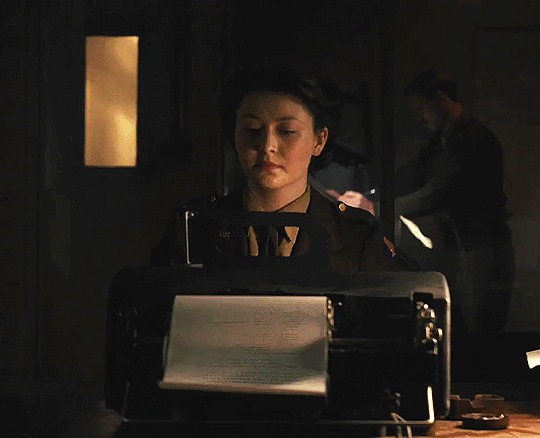

Next we see an enlisted WAC preparing for the debriefs the men will receive. She's a T3 or Technician 3rd Grade. You can see the rank patched on her shirt which has 3 chevrons and a T. There's also the 8th Air Force patch on her left sleeve. She's doing the work of a plotter. Placing the models of the planes into the locations of the formations that will be formed in the next mission.


Both WACs have perfect hair. Perfect. WACs were required to keep their hair neat and off their collar. If your hair was longer than your shoulders then you needed to put it up and the back gibson roll was the most popular way to do it. They've also kept their top rolls more to the side and smaller than usual victory rolls to accommodate their caps should they need to wear them (WACs were not required to wear their caps indoors)
In summary: I'm so damn impressed with the women in this show!!!! Overall the uniforms and costumes and hairstyles are SO GOOD! They clearly did their research when including the women and I'm so grateful for it. I'm fairly certain we'll be seeing the ATS in a future episode if the on set photos I've seen are any indication so if that happens I'll totally add that in a reblog. As well as any other glimpses of the women we get. I'm excited to see more of them!!
#wwii#period dramas#women in wwii#women's army corps#wac#masters of the air#hbo war#land army#red cross#red cross donut dollies#mod post#wwii history#women's history#women's land army#red cross clubmobile#the women of masters of the air
52 notes
·
View notes
Text
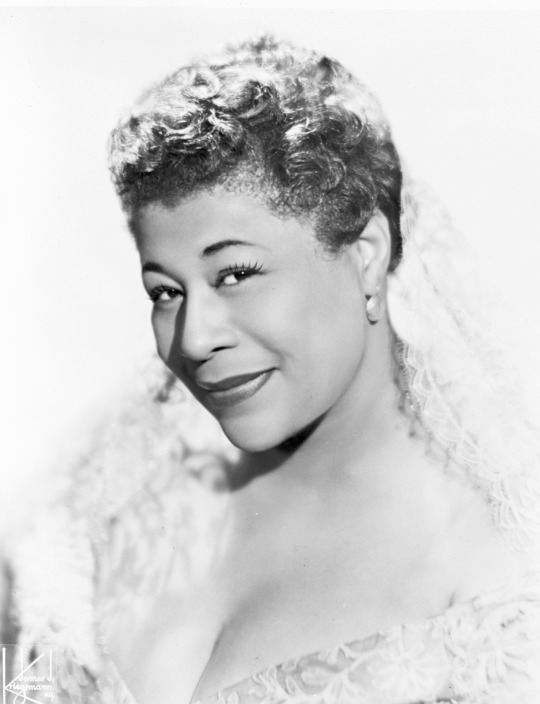
Promo photo for Jazz at the Philharmonic Concert in Paris 1957, NARA ID 20012478.
#OTD 1934: Ella Fitzgerald Debuts at Amateur Night at the Apollo!
First Lady of Song AND Civil Rights activist
By Miriam Kleiman, Public Affairs
On the evening of November 21, 1934, 17 year-old Ella Fitzgerald took the stage on Amateur Night at Harlem’s Apollo Theater and launched her longtime career as the “First Lady of Song.” She sang for presidents, was the first Black woman to win a Grammy (she won 13 Grammy awards) and sold over 40 million albums.
She was also a Civil Rights activist who used her talent to break racial barriers. In recognition of her work she was awarded the NAACP Equal Justice Award and the American Black Achievement Award. The National Archives holds records documenting the discrimination she faced -- and fought.
Ella Fitzgerald et al v. Pan Am: Racism or “honest mistake”?
On tour in 1954 en route to a concert in Australia she was denied the right to board a Pan American flight. She had to spend three days in Hawaii before other transportation to Australia could be secured, and she missed her concert dates.
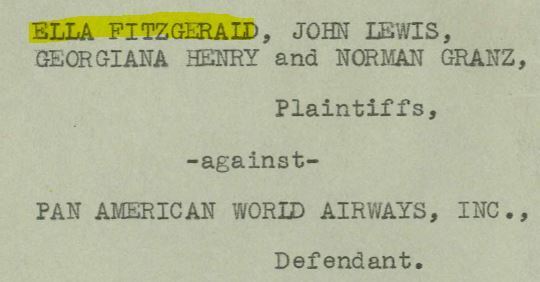
She sued Pan Am, claiming racism and seeking financial compensation. Pan Am claimed it was “an honest mistake” due to a reservation mix-up. The district judge dismissed the complaint, but the plaintiffs appealed. The U.S. Court of Appeals for the Second Circuit reversed that decision, ruling in favor of the plaintiffs.

New York Times, 12/31/1954.
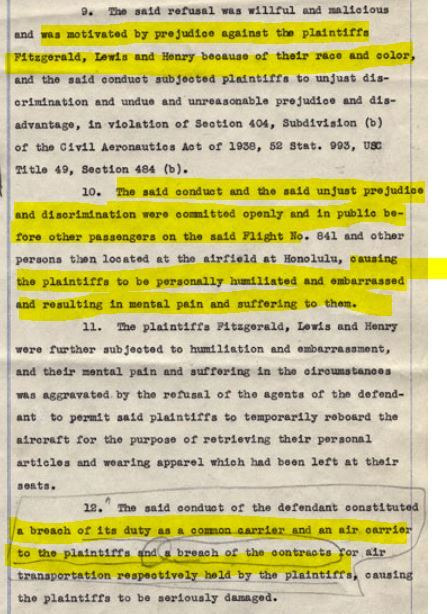
Complaint, Ella Fitzgerald, John Lewis, Georgiana Henry, and Norman Granz v. Pan American, Inc., 12/23/1954 Records of U.S. District Courts NARA ID 2641486.
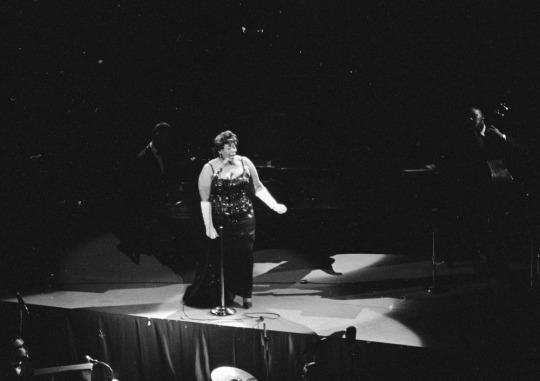
Ella Fitzgerald Performs at Birthday Salute to JFK at Madison Square Garden 5/19/1962, JFK Library ID ST-212-15-62.

President Gerald R. Ford and First Lady Betty Ford with Ella Fitzgerald at White House Bicentennial concert 6/20/1976, Ford Library, NARA ID 7840021.
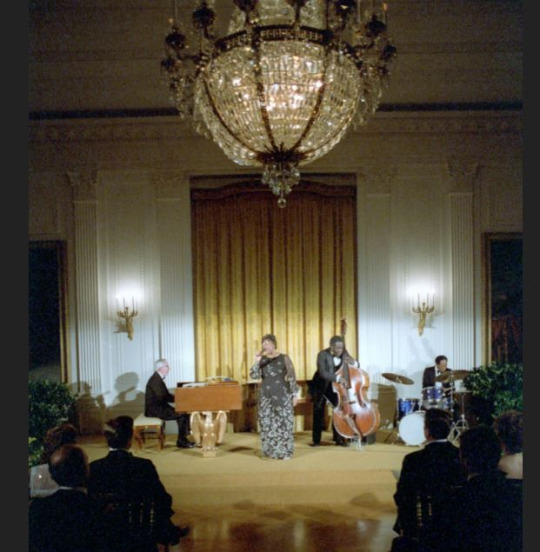
Ella Fitzgerald Performs at the White House State Dinner for King Juan Carlos I of Spain, 10/13/1981, Reagan Library, NARA ID 75855955.
More online:
See the complaint in the Documented Rights online exhibit under “Challenging Discrimination.”
DocsTeach: Complaint in the Case of Fitzgerald v. Pan American Airways, 12/23/1954
DocsTeach: Judgment in the Case of Fitzgerald v. Pan American World Airways, 1/26/1956.
Hear Fitzgerald discuss this incident, the lawsuit, and her legal victory: Ella Fitzgerald kicked off a plane because of her race: CBC Archives.
#OTD#blm#black lives matter#jazz#jazz history#women's history#equity#civil rights#justice#ford library#reagan library#social justice#black excellence#racial justice#ella fitzgerald#first lady of song#black history
492 notes
·
View notes
Text
Tallulah Bankhead - The Original Wild Child
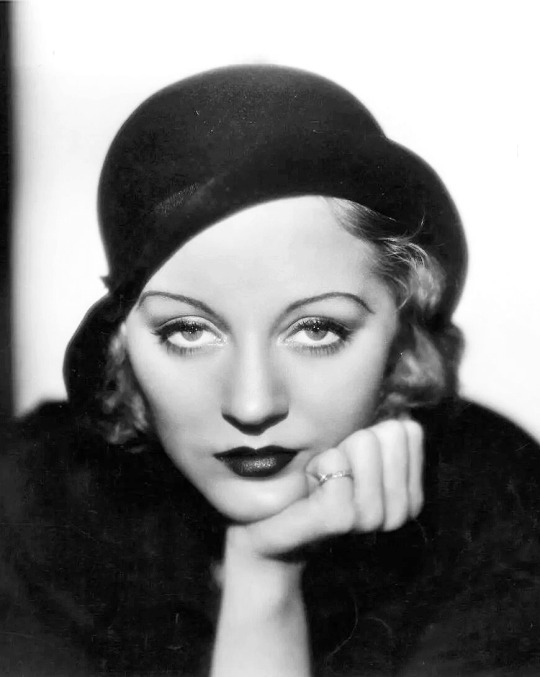
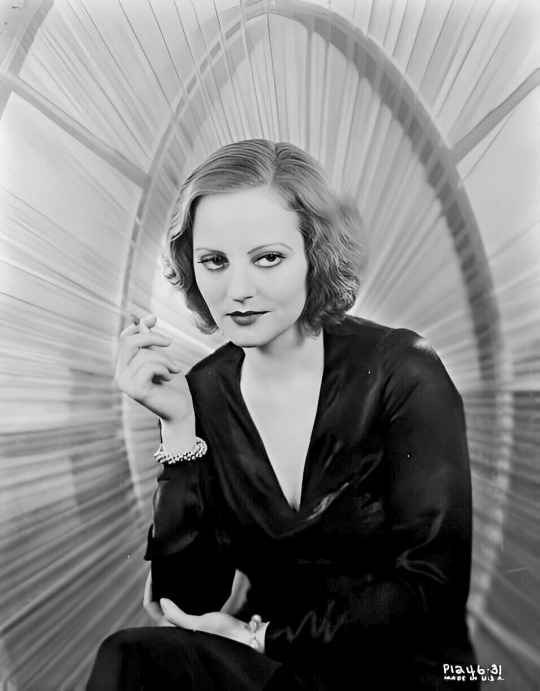


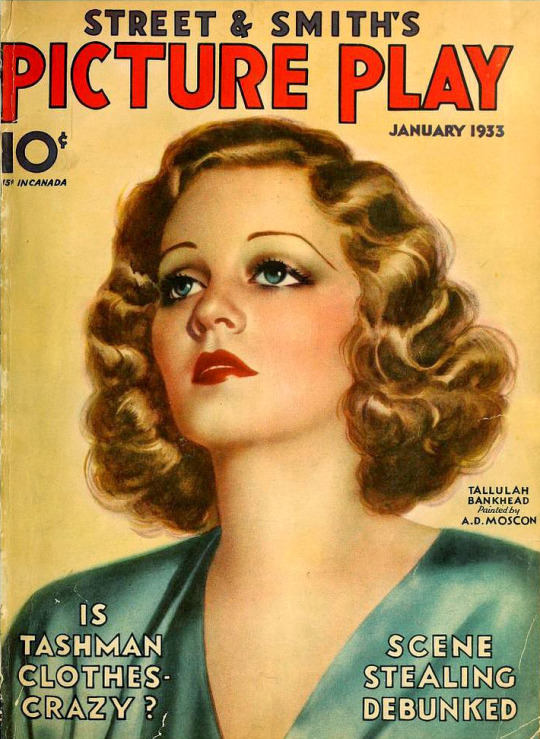
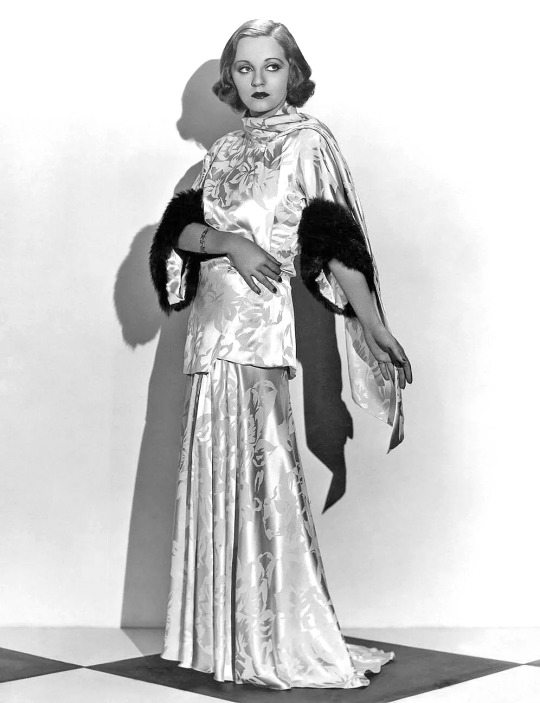


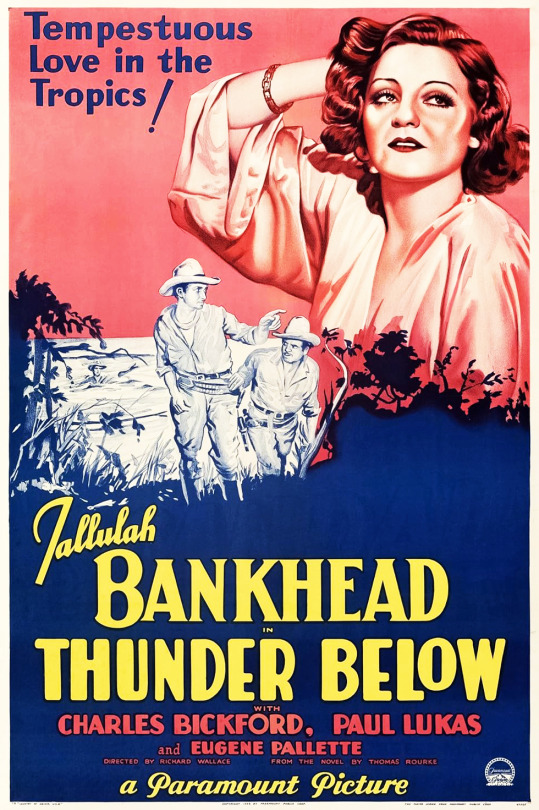
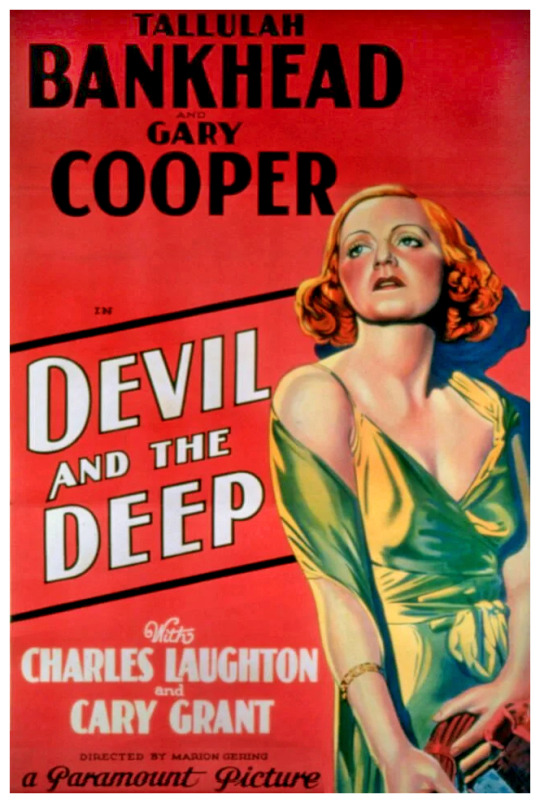
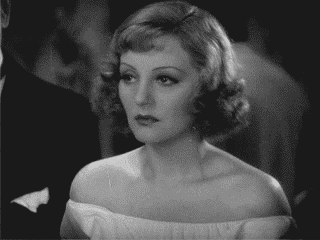
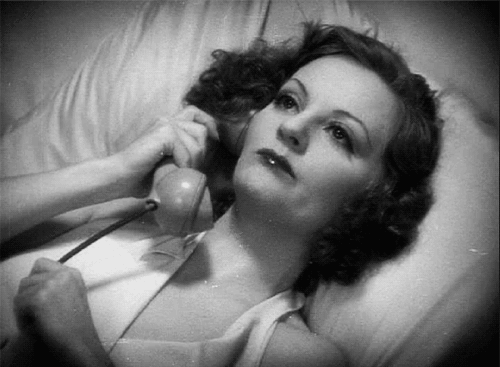
Tallulah Brockman Bankhead (January 31, 1902 – December 12, 1968 in Huntsville, Alabama) was an American actress, primarily of the stage, but has also appeared in several prominent films, including an award-winning performance in Alfred Hitchcock's Lifeboat (1944). Known as "The Original Wild Child," her penchant for living life on her own terms, defying societal conventions and hard partying sometimes preceded her talent.
Bankhead was a member of the Bankhead and Brockman family, a prominent Alabama Democratic political family with Irish roots. Her grandfather and her uncle were U.S. senators, and her father was Speaker of the House of Representatives. She was mostly raised in the family estate named "Sunset" in Jasper, Alabama.
Discovering at an early age that theatrics gained her the attention she desired, she wanted to be a performer. Thus, at 15, she submitted her photo to Picture Play, which was conducting a contest, and was awarded a trip to New York plus a movie part based on their photographs. She soon realized her place was on stage rather than screen. After several years in Broadway, Bankhead moved to London, where she found fame and critical acclaim in the West End.
In 1931, under contract to Paramount Pictures she returned to the U.S. and played in a series of roles as a femme fatale in films in films like George Cukor's Tarnished Lady (1931).
Going back to Broadway, Bankhead worked steadily in a series of plays, including brilliant portrayals of Regina Giddens in Lillian Hellman's The Little Foxes (1939) and Sabina in Thornton Wilder's The Skin of Our Teeth (1942). Because of her continued success, she was able to command 10 percent of the gross of the play and was billed larger than any other actor in the cast. She also continued to appear in a handful of films, TV shows, and radio shows. Though Tallulah Bankhead's career slowed in the mid-1950s, she never faded from the public eye.
A long time smoker, she died at St. Luke's Hospital in Manhattan at age 66 due to pleural double pneumonia.
Legacy:
Won the Variety Award for Best Actress of the Year twice: The Little Foxes (1939) and The Skin of Our Teeth (1942)
Won the New York Drama Critics Award for Best Actress in a Production for The Skin of Our Teeth (1942)
Won the New York Film Critics Circle Award for Best Actress for Lifeboat (1944)
Nominated for a Tony Award for Best Actress in a Play for Midgie Purvis (1961)
Has had a cocktail at the Rivoli Bar in the Ritz London called "The Tallulah," which is served in Christian Louboutin stiletto
Is the first white woman to be featured on the cover of Ebony magazine
Is one of the very few film actresses and the only stage actress to have a cover on both Time and Life
Honored as one of the 10 most remarkable women in London in 1928
Served as inspiration for the character Margo Channing in All About Eve (1950) and Cruella De Vil in Walt Disney Pictures' One Hundred and One Dalmatians (1961)
Is one of the original inductees in the American Theater Hall of Fame in 1972
Inducted in the Alabama Women's Hall of Fame in 1981
Is the main character of Looped, a Broadway play by New York writer Matthew Lombardo, which premiered in 2007
Has a star on the Hollywood Walk of Fame for her contributions to motion pictures at 6141 Hollywood Blvd since 1960

#Tallulah Bankhead#Tallulah#The Original Wild Child#Cruella#Cruella De Vil#Silent Films#Silent Movies#Silent Era#Silent Film Stars#Golden Age of Hollywood#Classic Hollywood#Film Classics#Classic Films#Old Hollywood#Vintage Hollywood#Hollywood#Movie Star#Hollywood Walk of Fame#Walk of Fame#Movie Legends#Actress#hollywood actresses#hollywood icons#hollywood legend#movie stars#1900s
26 notes
·
View notes
Text

Edna Mae Harris (September 29, 1914 – September 15, 1997), sometimes credited as Edna May Harris was an American actress and singer. Harris was one of the first African–American film actress of the late 1930s and early 1940s, appearing in films featuring mostly African–American casts.
Born in Harlem, Harris parents were Sam, a boxer and customs inspector; Her mother Mary Harris (née Walker) worked as a maid. Harris' family is noted as one of the first families to have migrated to Harlem. Settling near the Lafayette Theater, Harris was convinced into pursuing a career in show business by Ethel Waters and Maud Russell who were frequent visitors to her family home. After being coached on her singing and dancing by Waters and Russell, Harris began performing in the Theater Owners Booking Association (TOBA). An African-American vaudeville circuit, Harris performed with TOBA from 1929 until 1933.
Harris attended Wadleigh High School (later known as Wadleigh High School for Girls) in Manhattan. During the summer after her sophomore year of high school, Harris worked at the Alhambra Theater doing dramatic sketches with a stock company. During this period, Harris received excellent training in diction and stage delivery through her association with veteran performers. Harris was also an excellent swimmer in high school, and in 1928 she entered the New York Daily News' Swimming Meet and won a championship.
Harris first real Hollywood break came when she landed a part in The Green Pastures (1936), portraying Zeba, starring with Eddie 'Rochester' Anderson. Harris was a leading lady in Spirit of Youth (1938), the story of the rise of boxer Joe Thomas, which paralleled the life of Joe Louis. Harris also had leading roles in Oscar Micheaux films, Lying Lips (1939), and The Notorious Elinor Lee (1940). Her film credits also include such Hollywood films as Bullets or Ballots (1936), Private Number (1936), and Garden of Allah (1936), and the independent film Paradise in Harlem in 1939. Between picture commitments she toured with Noble Sissle's Orchestra as a featured vocalist along with Lena Horne and Billy Banks. In 1942, she played fourteen weeks at the old Elks' Rendezvous as the mistress of ceremonies and announced a weekly radio show over station WMCA in New York City. She also did character dialect parts on many broadcasts for the Columbia Workshop Program. Edna Mae Harris got to tell her story in her later years in the documentary, Midnight Ramble (1994), about independently produced black films.
Harris was married twice and had no children. Her first marriage was to Edward Randolph from 1933 until 1938, then to Harlem nightclub owner Walter Anderson from 1951 until his death in 1983. Harris dated boxer Joe Louis sometime during 1939 and 1940. Harris dated Robert Paquin, who co-starred with her in the Lying Lips from 1941 until 1942. Harris died of a heart attack on September 15, 1997 at the age of 82.
#black literature#black tumblr#black excellence#black community#civil rights#black girl magic#blackexcellence365#beautiful#strong black woman
25 notes
·
View notes
Text
William Hootkins in the 1970s.

William Hootkins was born in Texas in 1948. He was active in theater in High School and at Princeton University and interested in becoming a professional actor after graduating. His his friend John Lithgow recommended he move to England to continue his acting education, probably because he knew he'd get greater opportunities. So he moved to England in the 1970s and trained at The London Academy of Music and Dramatic Art. He continued mainly in theater and took film roles when he could. His first film role was a small role as a henchman in the British R rated film, Big Zapper in 1973.


Big Zapper, 1973. Small role and Hootkins would've been 24-25 years old during filming.

Anthology series Plays for Britain. Hootkins gets a small role in the episode The Paradise Run in 1976.


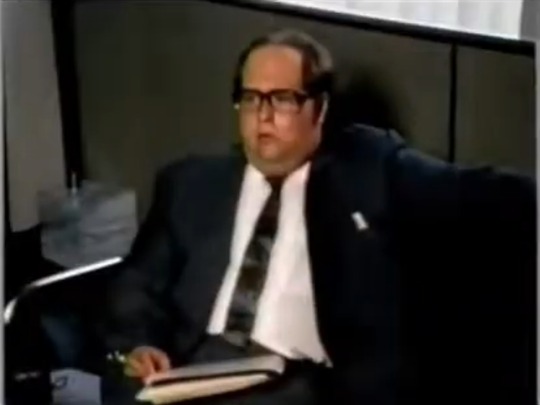

An anthology Documentary series, Horizon, which featured film adaptations of real-life events. Hootkins had a greater role in this 1976 offering Billion Dollar Bubble which starred James Woods about Insurance Company fraud in the early years of computers.


Still in his 20s, Hootkins got a small role in a major American film directed by Robert Aldrich and the opportunity to share a scene with Charles Durning, Twilight's Last Gleaming in 1977.



Also in 1977, Hootkins played Porkins in a small role in the 1977 blockbuster Star Wars. Small role but big enough to get his own action figure.
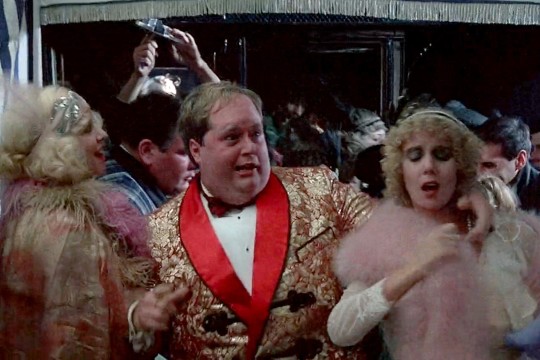
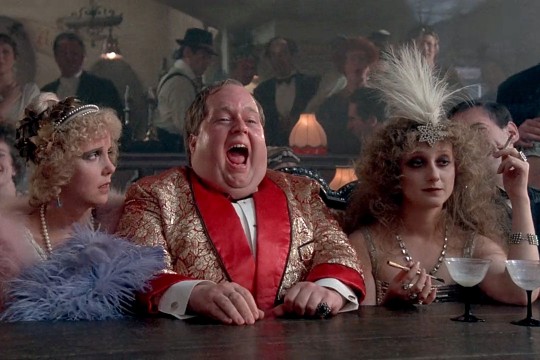
And again in 1977, Hootkins worked with Director Ken Russell in Valentino in a high energy scene of a drunken, egotistical silent film star. The movie was a bomb mainly because it wasn't the biopic of Rudolph Valentino that people expected. Russell took too much license in the life of Valentino to tell a more interesting story. I think what was known of the real lives of stars back then was greatly what the studio wanted to present to the public. So I think Russell was justified.
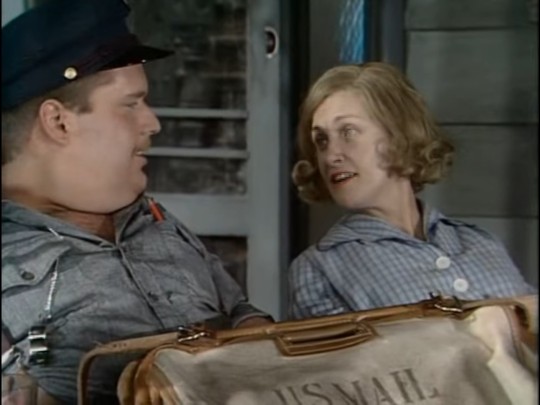

1977 was an especially good year for William Hootkins. The above photos are from a US-UK collaboration of a teleplay version of Come Back, Little Sheba starring Laurence Olivier and Joanne Woodward. Hootkins is in one scene only. Also in 1977, Hootkins appeared in episodes of British TV series, Van der Volk, Yanks Go Home, Plum's Plots and Plans and Documentary Series, The Lively Arts.
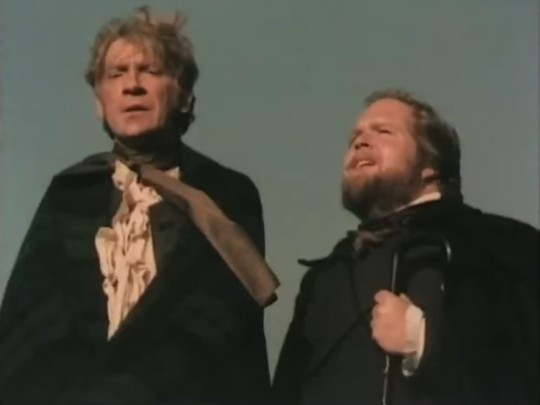

In 1978. Hootkins appeared in Part 1 of Clouds of Glory, a 2-part series of the lives of Poets, William Wordsworth and Samuel T Coleridge. Hootkins appeared with David Warner.
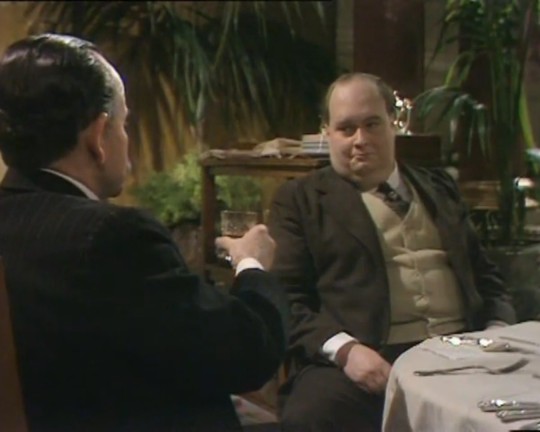

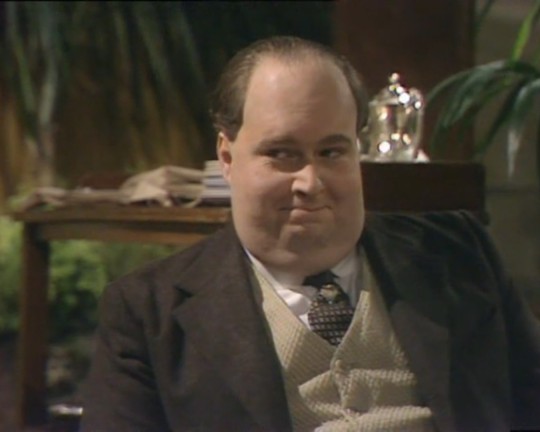
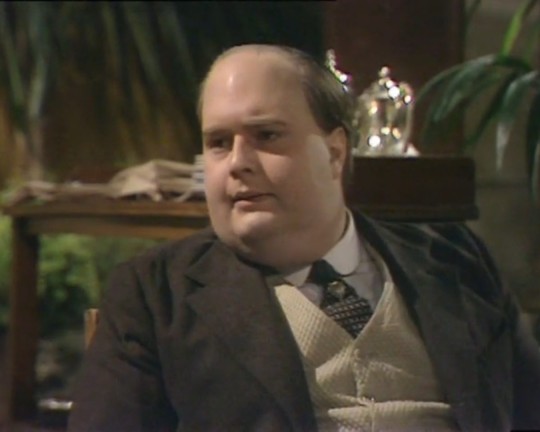
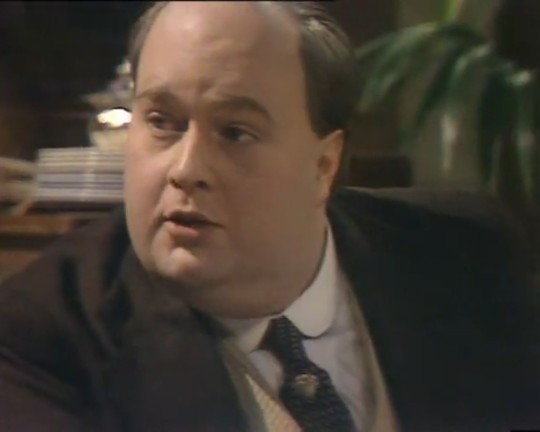
Late 1978, now William Hootkins is 30 years old and no denying the hair loss. He appears in all 3 episodes of the British miniseries The Lost Boys, about Peter Pan writer J. M. Barrie starring Ian Holm, presenting Barrie as homosexual and a pedophile (at least only in his mind). Hootkins plays Barrie's American friend, Broadway and London Theater Producer Charles Frohman.
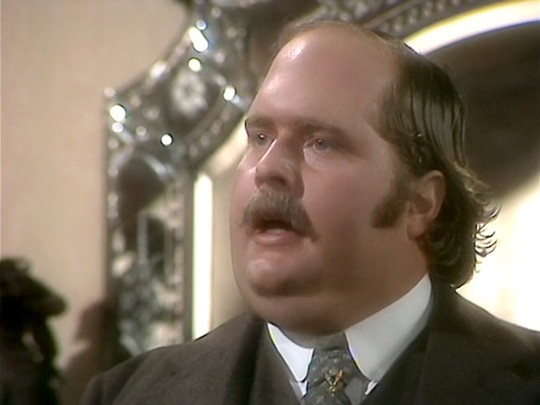

Hootkins appeared in one episode of British 13-part miniseries Lillie, the story of Lillie Langtry in 1978.

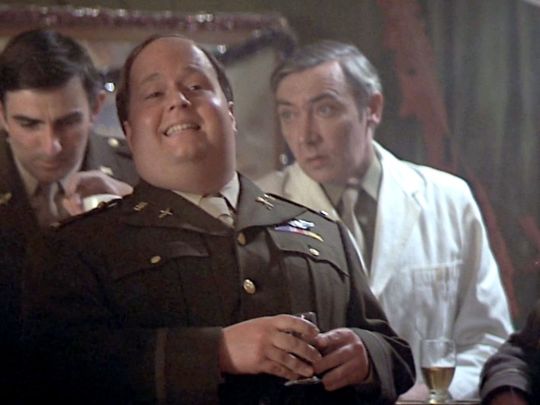
In 1979, Hootkins appeared in Hanover Street as Beef with Harrison Ford.

Also in 1979, he played a very small role in a remake of The Lady Vanishes with Cybill Shepherd and Angela Lansbury.
36 notes
·
View notes
Note
Not that this is the only example, but just watched "Lady Bird" where a major part of the plot is if the protagonist will go to NYU or UC Davis. As somebody who doesn't live in the United States and there aren't any "private universities" here just wondering if state schools are so bad? Why do they have such bad reputations or maybe just I'm just thinking too much of American-made entertainment?
This is a great question, because it allows me to talk about a topic that I find endlessly fascinating: how the cultural politics of class intersect with higher education.
With regards to Lady Bird, I think the first thing to understand is that it's a highly autobiographical film: Greta Gerwig also grew up in Sacramento, her parents had the same jobs as Lady Bird's parents, and Greta was also a theater kid who ended up going to a prestigious private university in New York City because she wanted to have a career in the performing arts. So what we're getting is not necessarily a universal experience, but how Greta Gerwig herself felt when she was a teenager.
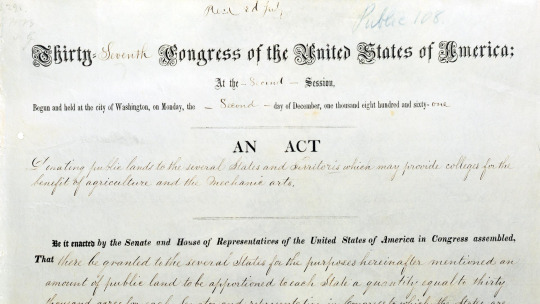
Second, state schools are not bad but their reputations are ...complicated. The land grant universities are generally reasonably well-resourced, they have good reputations, and they provide an extremely solid middle class credential that provides a major pathway for social and economic mobility in the United States.
However, there is usually a hierarchy within the state school systems between the flagship campus(es) which are usually nationally ranked research universities - U.C Berkeley, UCLA, Ann Arbor (UMichigan), University of Wisconsin-Madison, UMass Amherst, etc. - and the other campuses in the same system, which tend to be less selective, less nationally well-known, and more focused on teaching.
This sometimes leads to state schools having a reputation among middle-class to affluent families with college educations as being less "aspirational" compared to selective private universities. (This doesn't apply to the flagship campuses, because they are more selective and thus more similar to elite private universities in terms of their reputations.) Kids from those families still apply to (and attend) state schools in large numbers, but the term that's often used for them is "safety schools" - they're the schools you apply to in case you don't get into the highly selective private schools who take 10% or less of their applicants.
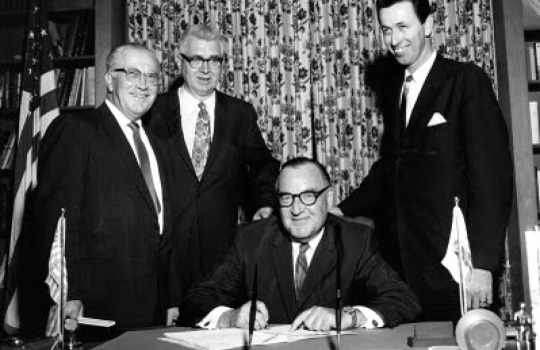
Third, NYU versus UC Davis is actually a slightly odd fit for the "state school" versus "private university" comparison. NYU is not actually that selective: it takes in 13% of applicants, which makes it about the 40th most selective college in the U.S. That's surprisingly low down the totem pole, given that the annual cost of attending NYU would be around $84,000 for Lady Bird. (NYU actually has to be less selective than other private universities, because it has a fairly small endowment compared to the selective private universities, and is thus more reliant on tuition dollars for revenue.)
However, Lady Bird's conflict isn't so much about academics generally - it's more specific than that. Remember that Lady Bird/Greta Gerwig is a theater kid who wants a career in the performing arts. If you narrow your focus from which is the best university overall to which university has the best Film Studies program, NYU is the second-best film school in the country, and because it's right in NYC there's a direct pipeline to one of the main hubs of the film and tv industry.
At the same time, Lady Bird probably should have done a bit more research about California's public university system. Because of the legacy of the California Master Plan, there is a robust transfer system within California's public universities that allows students who are really on the grind to move their way up, so that you can potentially start at the least selective community colleges and end up graduating from the most selective flagship UC campuses. So Lady Bird could have easily gone straight from UC Davis to UCLA (because while UCLA takes in only ~11% of applicants, making it more selective than NYU, it takes in about 24% of transfers), which is also one of the best film schools in the country with a direct pipeline to Hollywood, and it doesn't cost $84,000 a year.
(Ironically, Greta Gerwig herself didn't actually end up going to film school - she ended up going to Barnard which isn't particularly known for film, ended up going into English Lit because she was intending to be a playwright, before becoming a breakout actor in the indie film world, and then zig-zagging from there into directing and back into writing.)
122 notes
·
View notes
Text
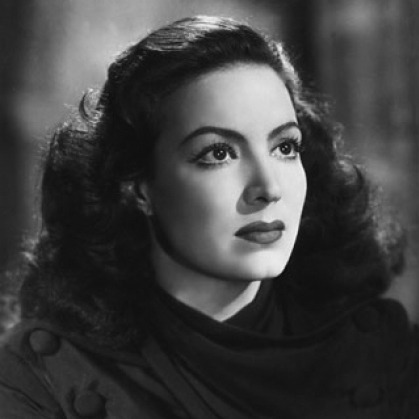

Propaganda
María Félix (Doña Barbara, La Mujer sin Alma, Rio Escondido, La Cucaracha)—Maria Felix is still possibly the most well-known Mexican film actress. She turned down multiple-roles in Hollywood and a contract with Metro-Goldwyn-Meyer in order to take roles in Mexico, France, and Argentine throughout the 1940s, 50s, 60s. She was so famous and so respected as a dramatic actress that she inspired painters, novelists and poets in their own art--she was painted by Diego Rivera, Jose Orozco, Bridget Tichenor. The novelist Carlos Fuentes used her as inspiration for his protagonist in Zona Sagrada. She inspired an entire collection by Hermes. In the late 1960s Cartier made her a custom collection of reptile themed jewels. She considered herself to be powerful challenger of morality and femininity in Mexico & worldwide--she routinely played powerful women in roles with challenging moral choices and free sexuality. But even still, years after he death, she is celebrated with Google Doodles, and appearances in the movie Coco, and holidays for the anniversary of her death.
Maureen O’Hara (The Parent Trap, The Quiet Man)—They called her the Queen of Technicolor. That right there should help introduce people to the fiery, wonderful, stunning Maureen O’Hara. She was from Ireland, born in 1920, and started in theater at the age of ten. At 15, she was winning drama awards, including one for her performance as Portia in the Merchant of Venice. At 16, she was the youngest pupil to graduate from the Guildhall School of Music. By 18, she transitioned to film, starting off with a bang alongside Charles Laughton in Hitchcock’s Jamaica Inn, and proceeded to work steadily up through the early 1970s. She was in adventures and comedies and romances, spent a lot of time in westerns giving merry hell to John Wayne (and less merry hell to the indomitable John Ford — she held her own even when he was verbally abusive and demeaning to her). She was in The Quiet Man, which was the first American-made film entirely filmed in a foreign country. She helped make American Christmas what it is with Miracle on 34th Street. She played a lineup of headstrong, forthright women second only, perhaps, to Katharine Hepburn. She was married three times, lived for a while with a boyfriend in Mexico, sued for custody of her daughter in the 1950s, AND sued a magazine for libel in the same era. After mostly retiring from acting, she edited a magazine. She eventually sold the magazine to spend more time with her grandson, but even then ran a ladies fashion store. She was an outspoken, brilliant, passionate lady, with amazing red hair, a career to envy, and — well — that face!
This is round 2 of the tournament. All other polls in this bracket can be found here. Please reblog with further support of your beloved hot sexy vintage woman.
[additional propaganda submitted under the cut]
María Félix:

She's Thee Hot Vintage Movie Woman of México. She's absolutely gorgeous and always looks like she's about to step on you. you WILL be thankful if she does.
"María Félix is a woman -- such a woman -- with the audacity to defy the ideas machos have constructed of what a woman should be. She's free like the wind, she disperses the clouds, or illuminates them with the lightning flash of her gaze." - Octavio Paz
María Félix is one of the most iconic actresses of the Golden Era of Mexican Cinema. La Doña, as she was lovingly nicknamed, only had one son, and when her first marriage ended in divorce her ex-husband stole her only child, so she vowed that one day she’d be more influential than her ex and she’d get her son back. AND SHE DID! María Félix rejected a Hollywood acting role to start her acting career in Mexico on her own terms with El Peñón de las Ánimas (The Rock of Souls) starring alongside actor, and future third husband, Jorge Negrete. She quickly rose to incredible heights both in Mexico and abroad, later on rejecting a Hollywood starring role (Duel in the Sun) as she was already committed to the movie Enamorada at the planned filming time. Of this snubbing she said, quote: “I will never regret saying no to Hollywood, because my career in Europe was focused in [high] quality cinema. [My] india* roles are made in my country, and [my] queen roles are abroad.” (Translator notes: here the “india” role means interpreting a lower-class Mexican woman, usually thought of indigenous/native/mixed descent —which she had interpreted and reinvented throughout her acting career in Mexico— and what abroad was typically considered the Mexican woman stereotype, with the braids, long simple skirts, and sandals. This also references the expectation of her possibly helping Hollywood in perpetuating this stereotype for American audiences that lack the cultural and historical contexts of this type of role which would undermine her own efforts against this type of Mexican stereotypes while working in Europe) She was considered one of the most beautiful women in the world of her time by international magazines like Life, París Match, and Esquire, and was a muse to a vast number of songwriters (including her second husband Agustin Lara,), artists, designers, and writers. Muralist Diego Rivera described her as “a monstrously perfect being. She’s an exemplary being that drives all other human beings to put as much effort as possible to be like her”. Playwriter Jean Cocteau, who worked with her in the Spanish film La Corona Negra (The Black Crown) said the following about her, “María, that woman is so beautiful it hurts”. Haute Couture houses like Dior, Givenchy, Yves Saint Laurent, Balenciaga, Hérmes, among others, designed and dressed her throughout her life. She died on her birthday, April 8, 2002, at 88 years old, in Mexico City. She was celebrated by a parade from her home to the Fine Arts Palace in the the city’s Historic Downtown, where a multitude of people paid tribute to her. Her filmography includes 47 movies from 1942 until 1970, and only two television acting roles in 1970. She has 2 music albums, one recorded with her second husband, Agustín Lara, in 1964 titled La Voz de María y la inspiración de Agustín «The voice of María and the inspiration of Augustín», and her solo album Enamorada «In Love» in 1998. Her bespoke Cartier jewelry is exhibited alongside Elizabeth Taylor’s, Grace Kelly’s and Gloria Swanson’s. In 2018, Film Director Martin Scorsese presented a restored and remastered version of her film Enamorada in the Cannes Classics section of the Cannes Festival and Google dedicated a doodle for her 104th birthday. On august 2023 Barbie added her doll to the Tribute Collection.

Maureen O'Hara:
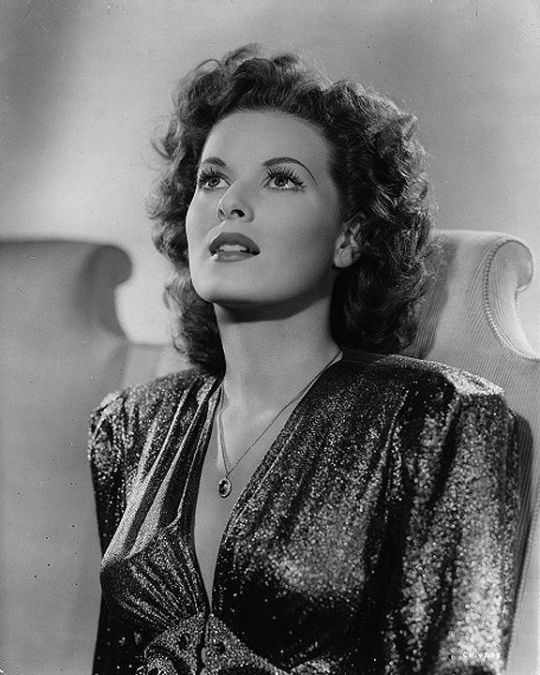
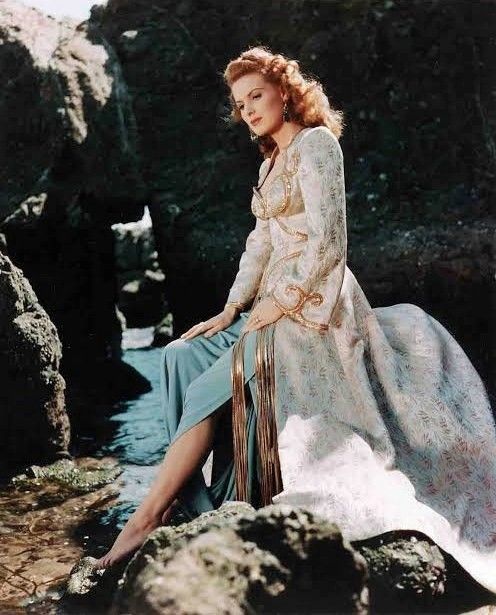
I thought she was one of the most beautiful women in the world when I was a kid and I have yet to really change my mind. Always loved her temper and her red hair. Plus she was kind of a MILF in The Parent Trap

Haughty, red hair, hot.
I would have to give up my passport if I didn't submit Maureen O'Hara but also have you seen her? Not only did she look like that (she was called the Queen of Technicolor, though she wasn't a big fan of that sobriquet), she was also very funny and tough as nails. She faced off against Walt Disney in a contract dispute and the legend goes that when someone mentioned her at his deathbed, he sat up and said 'That bitch!'. Her comment on that story is "At least he didn't think of me and say, 'That wimp'." She struggled to get serious roles for a time, saying ""Hollywood would never allow my talent to triumph over my face," so she plays the sexy princess/pirate/harem girl in a LOT of early movies that she referred to as "Tits and Sand" films, she being the tits in question. She also turned down so many leading men and studio bosses (Errol Flynn and Howard Hughes are among her rejects) that there were rumours spread that she was a lesbian. Many egos were battered it seems. I'm including the infamous Lady Godiva scene in the photo propaganda for the sheer Moment of it [link] . It was a bit of a flop critically, but it was one of Clint Eastwood's first film appearances and she said he told her later that he was very glad of the money at the time.
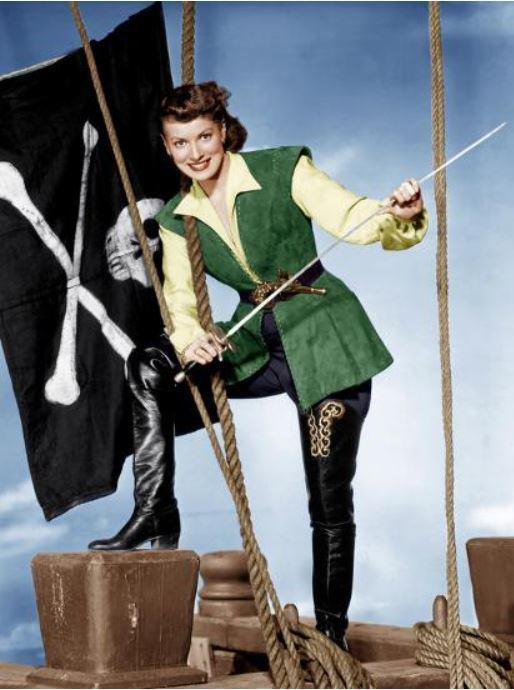

She was a very proud Irish woman and when she went for her American citizenship they insisted on referring to her as British (the timeline of Irish independence is a bit wibbly wobbly, we won't get into it here). She refused to accept American citizenship under that condition and argued her way through every level of US immigration she could find, supposedly saying "I'm not responsible for your antiquated records here in Washington", until a judge finally gave up and said "Give her what she wants, just get her out of here". This made her the first ever person seeking US citizenship to be proclaimed Irish on the record!

The hair. The accent. The figure. The acting chops. The perfection.

170 notes
·
View notes